Research Status and Prospects on the Construction Methods of Temperature and Humidity Environmental Models in Arbor Tree Cuttage
Abstract
1. Introduction
2. The Characteristics of Arbor Plant Cuttings
2.1. External Characteristics of Cuttings
| Cuttings Type | Notch Angle (°) | Length (cm) | The Number of Buds (Piece) | The Number of Leaves (Piece) | Depth of Insertion into Substrate (cm) | Rooting Rate (%) | Related Research |
|---|---|---|---|---|---|---|---|
| Salix Mongolica | 45 | 100 | 3~5 | 2 | 66.7 | 97.92 | Zha et al. [6] |
| Fir | 45 | 15 | 1 | Retain the Needle Leaves Above 2 cm at the Lower End | 2 | 85.83 | Chen et al. [7] |
| Toona Ciliata | 45 | 10 | 2 | 2~3 | 94.44 | Chen et al. [5] | |
| Birchleaved Pear | 45 | 10~15 | 1 | 3~5 | 3.33~5 | 70 | Wang et al. [24] |
| Cherry Rootstock (Gisela) | 45 | 10~12 | 1~3 | 3.33~4 | 85 | Ren et al. [25] | |
| Peach Rootstock (GF677) | 45 | 10~15 | 2~3 | 3~4 | 3~4 | 83 | Tewfik [26] |
| Apple Rootstock (Laoshannaise) | 45 | 15~20 | 3~4 | 3~4 | 1.5~2 | 90 | Xiao [27] |
| Mountain Apricot | 45 | 8~10 | 2~3 | 66.7 | Dai et al. [28] |
2.2. Physiological Activities of Cuttings
3. Characteristics of Plant Hormones in Cuttings
3.1. Types of Plant Hormones in Cuttings
3.2. Influence of Temperature and Humidity on Plant Hormone Functions
4. Environmental Requirements for Cuttings
4.1. Factors Affecting the Ambient Temperature of Facility Agricultural Systems
4.1.1. Factors Affecting Air Ambient Temperature
4.1.2. Factors Affecting Substrate Ambient Temperature
4.2. Factors Affecting Environmental Humidity in Facility Agricultural Systems
4.2.1. Factors Affecting the Humidity of the Air Environment
4.2.2. Factors Affecting the Ambient Humidity of the Substrate
5. Construction Methods of Environmental Model in Facility Agriculture Systems
5.1. Environmental Mechanism Model of Facility Agriculture Systems
5.2. Environmental Data-Driven Model of Facility Agriculture Systems
6. Discussion, Conclusions, and Prospects
6.1. Discussion
6.2. Conclusions
6.3. Prospect
Author Contributions
Funding
Data Availability Statement
Acknowledgments
Conflicts of Interest
Nomenclature
| Symbols | |
| θ | The intrinsic contact angle in the equation Young, ° |
| θw | The intrinsic contact angle in the equation Wenzle, ° |
| θc | The apparent contact angle in the equation Cassie-Baxter, ° |
| θs | The contact angle of a surfactant drop on a solid surface, ° |
| θv | The contact angle of a surfactant drop on a gas surface, ° |
| r | Roughness |
| The ratio of solid contact area to total area | |
| The ratio of gas contact area to total area | |
| Solid-gas interfacial tension, N·m−1 | |
| Solid-liquid interfacial tension, N·m−1 | |
| Gas-liquid interfacial tension, N·m−1 | |
| K | Factors related to droplet properties |
| Ohnesorge bumber | |
| Reynolds number | |
| Weber number | |
| Surface characteristics of the wall hit, including roughness and wettability |
References
- Porfírio, S.; da Silva, M.D.G.; Cabrita, M.J.; Azadi, P.; Peixe, A. Reviewing current knowledge on olive (Olea europaea L.) adventitious root formation. Sci. Hortic. 2016, 198, 207–226. [Google Scholar] [CrossRef]
- Sang, Y.L.; Cheng, Z.J.; Zhang, X.S. Plant stem cells and de novo organogenesis. New Phytol. 2018, 218, 1334–1339. [Google Scholar] [CrossRef] [PubMed]
- Xu, L.; Huang, H. Genetic and epigenetic controls of plant regeneration. Curr. Top. Dev. Biol. 2014, 108, 1–33. [Google Scholar] [CrossRef] [PubMed]
- Liu, K.; Yang, A.; Yan, J.D.; Liang, Z.L.; Yuan, G.P.; Cong, P.H.; Zhang, L.Y.; Han, X.L.; Zhang, C.X. MdAIL5 overexpression promotes apple adventitious shoot regeneration by regulating hormone signaling and activating the expression of shoot development-related genes. Hortic. Res. 2023, 10, uhad198. [Google Scholar] [CrossRef] [PubMed]
- Chen, Q.; Chen, S.C.; Huang, K.Y. Propagation Techniques for Shoot Cuttings of Toona Ciliata. For. Sci. Technol. 2023, 604, 72–76. [Google Scholar] [CrossRef]
- Zha, S.; Shi, L.; Yu, F.Q.; Gao, R.; Wang, L.N.; He, P.; Hao, Y.Q.; Yang, H.F. Fast Propagation Technology of All-optical Spray softwood cuttings of Salix psammophila. J. Inn. Mong. Agric. Univ. (Nat. Sci. Ed.) 2023, 44, 18–25. [Google Scholar] [CrossRef]
- Chen, X.M.; Huang, K.Y.; Li, K.P.; Chen, Q.; Lan, X.; Dai, J.; Cheng, L.; Chen, S.C.; Dong, L.J.; Mo, S.F. The Cutting Propagation Technology of Cunninghamia lanceolata Clones. Agric. Res. Appl. 2021, 34, 40–45. [Google Scholar]
- Liu, Y.; Huang, X.Y.; Zhuang, Q.Q. Experimental Study on Cutting Propagation of Honeysuckle. Agric. Jilin 2019. [Google Scholar] [CrossRef]
- Mehri, H.; Mhanna, K.; Soltane, A.; El-Hassen, A.; Faiez, R.; M’hamed, A. Performance of olive cuttings (Olea europaea L.) of different cultivars growing in the agro-climatic conditions of Al-Jouf (Saudi Arabia). Am. J. Plant Physiol. 2013, 8, 41–49. [Google Scholar]
- Tsipouridis, C.; Thomidis, T.; Michailides, Z. Influence of some external factors on the rooting of GF677, peach and nectarine shoot hardwood cuttings. Aust. J. Exp. Agric. 2005, 45, 107–113. [Google Scholar] [CrossRef]
- Choab, N.; Allouhi, A.; El Maakoul, A.; Kousksou, T.; Saadeddine, S.; Jamil, A. Review on greenhouse microclimate and application: Design parameters, thermal modeling and simulation, climate controlling technologies. Sol. Energy 2019, 191, 109–137. [Google Scholar] [CrossRef]
- Saridakis, G.; Kolokotsa, D.; Dolianitis, S. Development of an intelligent indoor environment and energy management system for greenhouses using a fuzzy logic controller and LonWorks® pro-tocol. In Proceedings of the EPEQUB Conference, Milos, Greece, 6–7 July 2006; pp. 1–5. [Google Scholar] [CrossRef]
- Businger, J.A. The Glasshouse Climate, Physics of Plant Environment; Van Wijk. North-Holland Publishing Co.: Amsterdam, The Netherlands, 1963; pp. 270–318. [Google Scholar]
- Aaslyng, J.M.; Ehler, N.; Jakobsen, L. Climate control software integration with a greenhouse environmental control computer. Environ. Model. Softw. 2005, 20, 521–527. [Google Scholar] [CrossRef]
- Du, S.F.; Li, Y.X.; Ma, C.W.; Chen, Q.Y.; Yang, W.Z. Current situation on greenhouse environment control system modes in China. Trans. Chin. Soc. Agric. Eng. 2004, 20, 7–12. [Google Scholar]
- Miao, J.C.; Wang, R.H.; You, D. Intelligent agricultural greenhouse monitoring system based on the Internet of Things. Internet Things Technol. 2023, 13, 16–18. [Google Scholar] [CrossRef]
- Seo, K.K. A simulation study on an artificial neural network based automatic control system of a plant factory. Int. J. Control. Autom. 2013, 6, 127–136. [Google Scholar] [CrossRef]
- Guo, Y.; Gao, J.; Tunio, M.H.; Wang, L. Study on the Identification of Mildew Disease of Cuttings at the Base of Mulberry Cuttings by Aeroponics Rapid Propagation Based on a BP Neural Network. Agronomy 2022, 13, 106. [Google Scholar] [CrossRef]
- Lan, L.; Zhan, E.J. Effect of leaf number on development of new treetops and roots of rootstock cuttage of Malus asiatica Nakai. Shandong Agric. Sci. 2018, 50, 77–80. [Google Scholar] [CrossRef]
- Zhang, W.H.; Li, W.; Yin, J.J.; Feng, Y.J.; Ren, J.T.; He, C.Y. Experiment on hardwood cutting propagation of broussonetia papyrifera. For. Sci. Technol. 2023, 1–6. [Google Scholar] [CrossRef]
- Zhang, X.M.; Li, B.J.; Yang, F.; Yi, K. Study on Green Branch Cutting Propagation of Apple Rootstock. China Fruits 2009, 22–25. [Google Scholar] [CrossRef]
- Li, C.Y.; Yang, T.Z.; Gao, J.D.; Gao, J.D.; Wang, J.; Cai, H.C.; Du, X.M.; Wang, S.T.; Gong, G.H.; Wang, X.P.; et al. Research Progress on Anatomy Mechanism of Cutting Rooting of Apple Dwarf Rootstock. J. Shanxi Agric. Sci. 2017, 45, 1719–1720+1730. [Google Scholar] [CrossRef]
- Wang, G.P.; Chen, Q.F.; Fan, X.P.; Liu, W.; Guo, H. Key techniques for the cuttage propagation of ’Y-1’ apple dwarfing stock. Mod. Hortic. 2024, 47, 94–96. [Google Scholar] [CrossRef]
- Wang, Y.H.; Li, J.D.; Li, T.; Zhuang, M.D.; Wang, P.F.; Zhang, H.X.; Ma, H.; Zhang, Y.X.; Xu, J.F. Exploring the influencing factors of young branch cutting of Du Li. China Fruits 2023, 29–34+141. [Google Scholar] [CrossRef]
- Ren, H.M.; Jia, S.J.; Li, W.; Jiang, C.Y.; Ren, Y.M.; Liu, R. Cutting Techniques of Cherry Dwarf Rootstock Gisela Twig. Mod. Rural. Sci. Technol. 2023, 621, 58–59. [Google Scholar]
- Tewfik, A.A. Effect of IBA, planting media and type of cutting on rooting of Nemaguard peach rootstock under Egyptian Conditions. Int. Soc. Hortic. Sci. 2001, 592, 169–175. [Google Scholar] [CrossRef]
- Xiao, Z.F. Impact of Juvenility on the Adventitious Rooting of Leafy Cuttings in Apple Rootstocks. Master’s Thesis, China Agricultural University, Beijing, China, 2014. [Google Scholar]
- Dai, J.L.; Zhang, S.L.; Wu, R.H.; Bai, Y.E. Research progress on seedling-cultivation techniques of wild apricot. China Fruits 2019, 200, 17–21. [Google Scholar]
- Yoon, A.; Oh, H.E.; Kim, S.Y.; Park, Y.G. Plant growth regulators and rooting substrates affect growth and development of Salix koriyanagi cuttings. Rhizosphere 2021, 20, 100437. [Google Scholar] [CrossRef]
- Dawa, S.; Rather, Z.A.; Stobgais, T.; Angdus, T.; Lakdan, S.; Tundup, P. Effect of growth regulators and growth media on the rhizogenesis of some genotypes of rose through stem cuttings. Int. J. Curr. Microbiol. App. Sci. 2018, 7, 1138–1147. [Google Scholar] [CrossRef][Green Version]
- Kalanzi, F.; Mwanja, C.K. Effect of nodal cutting position and plant growth regulator on bud sprouting of Dendrocalamus giganteus Wall. Ex Munro in Uganda. Adv. Bamboo Sci. 2023, 2, 100016. [Google Scholar] [CrossRef]
- Xie, Y.; Chen, T.; Ren, H. Rhizome Weight and Number of Sectioning per Rhizome Determine Plantlet Growth and Propagation Rate of Hemerocallis citrina Baroni in Cutting Propagation. Agronomy 2022, 12, 2777. [Google Scholar] [CrossRef]
- Markovski, A.; Popovska, M.; Gjamovski, V. Investigation of the possibility for production of some stone fruit rootstocks by rooting cuttings. Acta Agric. Serbica 2015, 20, 75–83. [Google Scholar] [CrossRef]
- Natale, S.; Tomasella, M.; Gargiulo, S.; Petruzzellis, F.; Tromba, G.; Boccato, E.; Nardini, A. Stem photosynthesis contributes to non-structural carbohydrate pool and modulates xylem vulnerability to embolism in Fraxinus ornus L. Environ. Exp. Bot. 2023, 210, 105315. [Google Scholar] [CrossRef]
- Qiu, J. Study on Cutting Propagation and Tissue Culture Techniques of Michelia ‘Zhongshanhanxiao’. Master’s Thesis, Nanjing Forestry University, Nanjing, China, 2023. [Google Scholar]
- Van Dongen, J.T.; Gupta, K.J.; Ramírez-Aguilar, S.J.; Araújo, W.L.; Nunes-Nesi, A.; Fernie, A.R. Regulation of respiration in plants: A role for alternative metabolic pathways. J. Plant Physiol. 2011, 168, 1434–1443. [Google Scholar] [CrossRef] [PubMed]
- Ariura, R.; Matsumoto, M.; Li, J.; Fuse, T.; Aoki, T.; Zhang, Y.; Watanabe, M. Effects of elevated ozone and carbon dioxide on the dynamic photosynthesis of Fagus crenata seedlings under variable light conditions. Sci. Total Environ. 2023, 891, 164398. [Google Scholar] [CrossRef] [PubMed]
- Chen, X.; Jiang, Z.; Tai, Q.; Shen, C.; Rao, Y.; Zhang, W. Construction of a photosynthetic rate prediction model for greenhouse strawberries with distributed regulation of light environment. Math. Biosci. Eng. 2022, 19, 12774–12791. [Google Scholar] [CrossRef] [PubMed]
- He, Y.; Matthews, M.L. Seasonal climate conditions impact the effectiveness of improving photosynthesis to increase soybean yield. Field Crops Res. 2023, 296, 108907. [Google Scholar] [CrossRef] [PubMed]
- Kichah, A.; Bournet, P.E.; Migeon, C.; Boulard, T. Measurement and CFD simulation of microclimate characteristics and transpiration of an Impatiens pot plant crop in a greenhouse. Biosyst. Eng. 2012, 112, 22–34. [Google Scholar] [CrossRef]
- Morille, B.; Migeon, C.; Bournet, P.E. Is the Penman–Monteith model adapted to predict crop transpiration under greenhouse conditions Application to a New Guinea Impatiens crop. Sci. Hortic. 2013, 152, 80–91. [Google Scholar] [CrossRef]
- Baglivo, C.; Mazzeo, D.; Panico, S.; Bonuso, S.; Matera, N.; Congedo, P.; Oliveti, G. Complete greenhouse dynamic simulation tool to assess the crop thermal well-being and energy needs. Appl. Therm. Eng. 2020, 179, 115698. [Google Scholar] [CrossRef]
- Rapaka, V.K.; Bessler, B.; Schreiner, M.; Druege, U. Interplay between initial carbohydrate availability, current photosynthesis, and adventitious root formation in Pelargonium cuttings. Plant Sci. 2005, 168, 1547–1560. [Google Scholar] [CrossRef]
- Li, N. Preliminary Study on Cutting and Tissue Culture Propagation Technology of Pterocarya stenoptera. Master’s Thesis, Nanjing Forestry University, Nanjing, China, 2021. [Google Scholar] [CrossRef]
- Qu, T.H. Experimental Study on Improving Lipid Productivity of Chlorella vulgaris by Supplementation Phytohormones and Light Quality Shift. Master’s Thesis, Chang’an University, Xi’an, China, 2022. [Google Scholar] [CrossRef]
- Wang, L. Study on Cutting Propagation Technique and Rooting Mechanism of SH40 Apple Dwarf Rootstock. Master’s Thesis, Hebei Agricultural University, Baoding, China, 2016. [Google Scholar]
- Liu, G.J.; Li, X.Y.; You, X.L.; Zhang, J.; Zhao, Y.H.; Liu, G.F. The Relationship between Endogenous Hormone Changes and Adventitious Root Production in the Cutting of Larix gmelinii. J. Northeast. For. Univ. 2000, 19–20. [Google Scholar] [CrossRef]
- Zhou, A.P.; Gan, P.H.; Zong, D.; Fei, X.; Zhong, Y.Y.; Li, S.Q.; Yu, J.; He, C.Z. Bark tissue transcriptome analyses of inverted Populus yunnanensis cuttings reveal the crucial role of plant hormones in response to inversion. PeerJ 2019, 7, e7740. [Google Scholar] [CrossRef] [PubMed]
- Bao, X.Y. Study on the Shoot Cutting Propagation Technology and Rooting Mechanism of Viburnum trilobum. Master’s Thesis, Jilin Agricultural University, Changchun, China, 2023. [Google Scholar]
- Li, H.D. Study of CuttingPropagation Technology and Biochemical Factors of Photiniax fraseri. Master’s Thesis, Kunming University of Science and Technology, Kunming, China, 2018. [Google Scholar]
- Niu, T.; Wang, H.X.; Zhang, L.; Li, C.X.; Wei, X.Y.; Sun, F.; Yu, Y.C.; Wang, C.X. Study on Cutting Rooting Characteristics and Anatomical Observation of Lagerstroemia indica. Shandong Agric. Sci. 2013, 45, 66–68. [Google Scholar] [CrossRef]
- Castañeda-Saucedo, M.C.; Tapia-Campos, E.; Ramírez-Anaya, J.P.; Beltrán, J. Growth and development of stevia cuttings during propagation with hormones in different months of the year. Plants 2020, 9, 294. [Google Scholar] [CrossRef] [PubMed]
- Chen, Y.B.; Sun, Z.W.; Jiang, N.; Zheng, X.J. Effects of of Shoot Age and Hormone on Cutting Propagation of Ampelopsis Grossedentata. Hubei Agric. Sci. 2017, 56, 4085–4087+4093. [Google Scholar] [CrossRef]
- Li, N. Studies on the Softwood Cutting Propagating Technology and Rooting Mechanism of Ulmus pumila L. Master’s Thesis, Shandong Agricultural University, Tai’an, China, 2016. [Google Scholar]
- Niu, L.S. The Effect of Different Environments, Substrates and Hormones on the Hard Branch Cutting of Seabuckthorn. Agric. Eng. Technol. 2020, 40, 27+30. [Google Scholar] [CrossRef]
- Du, X.M.; Gao, J.D.; Wang, J.; Cai, H.C.; Li, C.Y.; Wang, S.T.; Yang, T.Z. A Study on the Factors Influencing the Rooting of Green Branch cuttings in ‘Red Full Hall’. J. Shanxi Agric. Univ. (Nat. Sci. Ed.) 2023, 1–11. [Google Scholar] [CrossRef]
- Wang, M.G.; Zhang, J.C.; Liu, K.L.; Wang, D.Z.; Ma, J.M.; Zhao, P.; Sun, X.B.; Yu, Z.Y. Study on Hardwood Cutting of Acer buergerianum in Minqin Desert Area. Agric. Sci. -Technol. Inf. 2023, 137–140+148. [Google Scholar] [CrossRef]
- Zhao, Y.; Chen, Y.; Jiang, C.; Lu, M.Z.; Zhang, J. Exogenous hormones supplementation improve adventitious root formation in woody plants. Front. Bioeng. Biotechnol. 2022, 10, 1009531. [Google Scholar] [CrossRef]
- Druege, U.; Hilo, A.; Pérez-Pérez, J.M.; Klopotek, Y.; Acosta, M.; Shahinnia, F.; Zerche, S.; Franken, P.; Hajirezaei, M.R. Molecular and physiological control of adventitious rooting in cuttings: Phytohormone action meets resource allocation. Ann. Bot. 2019, 123, 929–949. [Google Scholar] [CrossRef]
- Fan, L.W. Exgenous Hormones in Acer Truncatum Twig Cutting Propagation Technology Application and Rooting Mechanism. Master’s Thesis, Shanxi Agricultural University, Jinzhong, China, 2017. [Google Scholar]
- Zhang, B.L.; Yu, S.Q.; Jiang, X.R.; Tu, S.P. NAA+IBA on rooting process in cuttings of Euscaphis konishii. J. Cent. South Univ. For. Technol. 2023, 43, 53–62. [Google Scholar] [CrossRef]
- Bartel, B.; LeClere, S.; Magidin, M.; Zolman, B.K. Inputs to the active indole-3-acetic acid pool: De novo synthesis, conjugate hydrolysis, and indole-3-butyric acid b-oxidation. J. Plant Growth Regul. 2001, 20, 198–216. [Google Scholar] [CrossRef]
- Peng, F.F.; Li, X.L.; Wei, Z.X.; Yang, H.J.; Han, G.H. Establishment of Rapid Propagation System of Mulberry by Tissue Culture and Branch Cutting in Vitro. Mol. Plant Breed. 2021, 19, 7547–7555. [Google Scholar] [CrossRef]
- Huang, J.W.; Li, M.; Tang, K.; Zhao, P.; Dong, S.; Li, L.M.; Li, Y.Q. Effect of Plant Growth Regulators on Rooting of Aquilaria sinensis Cuttings. Hubei Agric. Sci. 2015, 54, 2428–2431+2434. [Google Scholar] [CrossRef]
- Shi, F.H.; Zhao, R.; Luo, S.; Zheng, C.; Shen, Y.B. Study on plant hormone changes in soft cuttings of Tilia miqueliana during rooting. J. Cent. South Univ. For. Technol. 2019, 39, 21–26. [Google Scholar] [CrossRef]
- Wang, Y.H.; Yan, L.P.; Kong, Y.G.; Wu, D.J.; Ren, F.; Liang, J. Anatomy and endogenous hormone changes of softwood cutting rooting of Fraxinus velutina. J. Cent. South Univ. For. Technol. 2023, 43, 28–35+52. [Google Scholar] [CrossRef]
- Jia, B. Study on the Key Factors Affecting of Cerasus humilis Cuttings in Closed Box Environment. Master’s Thesis, Shanxi Agricultural University, Jinzhong, China, 2023. [Google Scholar] [CrossRef]
- Dong, X.H.; Shan, D.P.; Liu, L.C.; Shi, Y.Q.; Wang, C.L.; Sun, Y.; Sun, H.; Sun, D.L. The Effect of Different Rooting Agent Concentrations and Substrates on Industrial Cannabis Cutting. Spec. Econ. Anim. Plants 2023, 26, 15–16+27. [Google Scholar]
- Zhu, S.Y. Study on the Propagation Technologies and Rooting Mechanism of Green Branches Cutting in Tilia miqueliana. Master’s Thesis, Soochow University, Soochow, China, 2023. [Google Scholar] [CrossRef]
- Xu, C.G.; Zhang, C.Y.; Jin, Z.Y.; Che, D.D. Effect of IAA on the Rooting of Parthenocissus Thomsoni Cuttings. J. Agric. Sci. Technol. 2017, 19, 26–30. [Google Scholar] [CrossRef]
- Li, J.T.; Zhao, L.; Liang, H.R.; Yu, W.L.; Lu, M.; Wu, R.H.; Liu, P.S. Effects of Different Hormones and Concentration Treatments on Softwood Cutting Rooting of Picea abies. Inn. Mong. For. Investig. Des. 2021, 44, 95–100. [Google Scholar] [CrossRef]
- Liu, Z.C.; Yan, L.W.; Chen, Y.Y. The Effect of Low Temperature Treatment on the Growth and Physiological Characteristics of Passion Flower Cutting Seedlings. South China Fruits 2021, 50, 98–102. [Google Scholar] [CrossRef]
- Liu, Y.; Chen, X. Study on Several Factors influencing Flowering of Test-tube Plantlets Cultured in vitro of Rhododendron hybridum. J. Anhui Agri. Sci. 2008, 36, 9405–9407. [Google Scholar] [CrossRef]
- Tang, H. Study on the Optimization of the Reproduction System of Osmanthus fragrans and the Influence of Environmental Factors on Its Growth and Development in Cultivated Areas. Master’s Thesis, Chongqing Three Gorges University, Chongqing, China, 2021. [Google Scholar] [CrossRef]
- Henrique, A.; Campinhos, E.N.; Ono, E.O.; Pinho, S.Z.D. Effect of plant growth regulators in the rooting of Pinus cuttings. Braz. Arch. Biol. Technol. 2006, 49, 189–196. [Google Scholar] [CrossRef]
- Mesén, F.; Newton, A.C.; Leakey, R.R.B. The effects of propagation environment and foliar area on the rooting physiology of Cordia alliodora (Ruiz & Pavon) Oken cuttings. Trees 1997, 11, 404–411. [Google Scholar] [CrossRef]
- OuYang, F.; Wang, J.; Li, Y. Effects of cutting size and exogenous hormone treatment on rooting of shoot cuttings in Norway spruce [Picea abies (L.) Karst.]. New For. 2015, 46, 91–105. [Google Scholar] [CrossRef]
- Qiu, F.Y.; Zhong, Y.T.; Zhang, T.; Liu, X.L.; Li, J. Effect of scion types and leaves number on cutting propagati of Cinnamomum porrectum. South China For. Sci. 2018, 46, 25–28. [Google Scholar] [CrossRef]
- Gao, M.Q. Effects of Elevated Atmospheric CO2 and Temperature, Nitrogen Addition on the Photosynthetic Characteristics and Biomass Distribution of Hybrid Poplar Saplings. Master’s Thesis, Shanxi Agricultural University, Jinzhong, China, 2022. [Google Scholar] [CrossRef]
- Cao, X.; Du, W.; Shang, C.; Liu, L.; Cheng, J.L. Comparative transcriptome reveals circadian and hormonal control of adventitious rooting in mulberry hardwood cuttings. Acta Physiol. Plant. 2018, 40, 197. [Google Scholar] [CrossRef]
- Zhang, Y.T.; Ye, W.M.; Xiong, D.C.; Wu, C.; Huang, J.X.; Chen, S.D.; Yang, Z.J. Seasonal dynamics in photosynthetic characteristics and growth of Cunninghamia lanceolata saplings and their response to soil warming. Chin. J. Appl. Ecol. 2023, 1–9. [Google Scholar] [CrossRef]
- Shang, C.; Yang, H.; Ma, S.; Shen, Q.D.; Liu, L.; Hou, C.X.; Cao, X.; Cheng, J.L. Physiological and transcriptomic changes during the early phases of adventitious root formation in mulberry stem hardwood cuttings. Int. J. Mol. Sci. 2019, 20, 3707. [Google Scholar] [CrossRef] [PubMed]
- Chen, F.F.; Zeng, X.Q.; Yang, Z.Y.; Yang, Z.L.; Duan, Z.J. Technology of Cephalotaxus mannii Cutting Seedlings and Research of Seedbed Environmental Regulation. Guangxi For. Sci. 2016, 45, 338–342. [Google Scholar] [CrossRef]
- Li, X.M. Cutting Propagation Techniques and Rooting Mechanism of Cyclocarya paliurus (Batal.) Iljinskaja. Master’s Thesis, Nanjing Forestry University, Nanjing, China, 2015. [Google Scholar]
- Kong, Z.Q. Effects of Environmental Factors and Cutting Treatment Methods on Rooting of Acca sellowiana Berg Cuttings. Master’s Thesis, Southwest University of Science and Technology, Mianyang, China, 2021. [Google Scholar] [CrossRef]
- Wang, X.X.; Zang, J.H.; An, J.R. Response of Grape Twig Cutting to Different Substrates, Temperature and Humidity. GanSu Agric. 2016, 32–33. [Google Scholar] [CrossRef]
- Puri, S.; Thompson, F.B. Relationship of water to adventitious rooting in stem cuttings of Populus species. Agrofor. Syst. 2003, 58, 1–9. [Google Scholar] [CrossRef]
- East, A.R.; Araya, X.I.T.; Hertog, M.; Nicholson, S.E.; Mawson, A.J. The effect of controlled atmospheres on respiration and rate of quality change in ‘Unique’feijoa fruit. Postharvest Biol. Technol. 2009, 53, 66–71. [Google Scholar] [CrossRef]
- Lebude, A.V.; Goldfarb, B.; Blazich, F.A.; Wise, F.C.; Framption, J. Mist, substrate water potential and cutting water potential influence rooting of stem cuttings of loblolly pine. Tree Physiol. 2004, 24, 823–831. [Google Scholar] [CrossRef] [PubMed]
- LeBude, A.V.; Goldfarb, B.; Blazich, F.A.; Frampton, J.; Wise, F. Mist level influences vapor pressure deficit and gas exchange during rooting of juvenile stem cuttings of loblolly pine. HortScience 2005, 40, 1448–1456. [Google Scholar] [CrossRef]
- Murthy, R.; Goldfarb, B. Effect of handling and water stress on water status and rooting of loblolly pine stem cuttings. New For. 2001, 21, 217–230. [Google Scholar] [CrossRef]
- Wei, D.D. Numerical Simulation of Thermal Environment and Ventilation Characteristics of solar Greenhouse. Master’s Thesis, Henan Agricultural University, Zhengzhou, China, 2022. [Google Scholar] [CrossRef]
- Dessy, S.; Radice, S.; Andorno, A.; Ontivero, M. Ferdor-Julior, Myran-Yumir and St. julien GF 655-2 rootstocks: Propagation by cuttings with growth regulators and bottom heat. Acta Hortic. 2002, 658, 629–635. [Google Scholar] [CrossRef]
- Druege, U.; Zerche, S.; Kadner, R. Nitrogen-and storage-affected carbohydrate partitioning in high-light-adapted Pelargonium cuttings in relation to survival and adventitious root formation under low light. Ann. Bot. 2004, 94, 831–842. [Google Scholar] [CrossRef] [PubMed]
- Zhu, T.F.; Li, X.; Su, X.L.; Zhou, Y.J.; Tang, K.F.; Yin, J.F.; Ren, H.P.; Wang, L.C. Analysis of the changes in the contents of cuttings during the cutting process of four species of fruit trees in the Rosaceae family. South China Fruits 2023, 52, 139–146. [Google Scholar] [CrossRef]
- Jia, T.; Li, Z.X. Preliminary report on the study of green branch cuttings Malus baccata Borkh. J. Shanxi Agric. Univ. 1984, 76–88. [Google Scholar] [CrossRef]
- Mayer, N.A.; Reighard, G.L.; Bridges, W. Peach rootstock propagation under intermittent mist system. Acta Hortic. 2013, 1084, 53–62. [Google Scholar] [CrossRef]
- Ye, Y.; Ou, C.Q.; Wang, F.; Zhang, Y.J.; Ma, L.; Li, S.R.; Liu, Y.L.; Jiang, S.L.; Lin, Y.G. Study on green branches cutting propagation of pear dwarfing rootstock ‘Zhong ai 1’. China Fruits 2023, 24–29+2. [Google Scholar] [CrossRef]
- Wang, H.M.; Zhang, H.F.; Dong, Z.X.; Dong, Z.; Wang, L.C.; Zhou, Z.J. Effect of Vermicompost, Cutting parts and Cutting Timeon Rooting of Fraxinus americana Shoot Cuttings. For. Sci. Technol. 2023, 48, 31–34+59. [Google Scholar] [CrossRef]
- Wang, J.L.; Shen, F.Y.; Chang, X.W.; Li, C.M.; Yang, L.X. Rooting characteristics of Betula costata softwood cuttings. J. Cent. South Univ. For. Technol. 2023, 43, 43–52. [Google Scholar] [CrossRef]
- Zhang, J. Study on Propagation Technology of Davidia involucrata Seedlings. Hortic. Seed 2023, 43, 36–37+69. [Google Scholar] [CrossRef]
- Zhang, C.H. Estimation model of Leaf Wetness Duration on Cucumber Leaves and Automatic Control in Solar Greenhouse Based on Temperatu. Master’s Thesis, Shihezi University, Shihezi, China, 2022. [Google Scholar] [CrossRef]
- Li, W.J. Frost Prevention Measures for Red Plum and Apricot Sheds and Numerical Simulation Based on CFD. Master’s Thesis, Ningxia University, Yinchuan, China, 2021. [Google Scholar] [CrossRef]
- Lamrani, M.A.; Boulard, T.; Roy, J.C.; Jaffrin, A. SE—Structures and Environment: AirFlows and Temperature Patterns induced in a Confined Greenhouse. J. Agric. Eng. Res. 2001, 78, 75–88. [Google Scholar] [CrossRef]
- Ali, H.; Bournet, P.; Cannavo, P.; Chantoiseau, E. Development of a CFD crop submodel for simulating microclimate and transpiration of ornamental plants grown in a greenhouse under water restriction. Comput. Electron. Agric. 2018, 149, 26–40. [Google Scholar] [CrossRef]
- Kacira, M.; Short, T.H.; Stowell, R.R. A CFD evaluation of naturally ventilated, multi-span, sawtooth greenhouses. Trans. ASAE 1998, 41, 833–836. [Google Scholar] [CrossRef]
- Cheng, X.; Li, D.; Shao, L.; Ren, Z. A virtual sensor simulation system of a flower greenhouse coupled with a new temperature microclimate model using three-dimensional CFD. Comput. Electron. Agric. 2021, 181, 105934. [Google Scholar] [CrossRef]
- Sethi, V.P.; Sumathy, K.; Lee, C.; Pal, D.S. Thermal modeling aspects of solar greenhouse microclimate control: A review on heating technologies. Sol. Energy 2013, 96, 56–82. [Google Scholar] [CrossRef]
- Bao, E.; Cao, Y.; Zou, Z.; Shen, T.; Zhang, Y. Research progress of thermal storage technology in energy-saving solar greenhouse. Trans. Chin. Soc. Agric. Eng. 2018, 34, 1–14. [Google Scholar] [CrossRef]
- Li, Y.; Sun, G.; Wang, X. Temperature field-wind velocity field optimum control of greenhouse environment based on CFD model. Math. Probl. Eng. 2014, 2014, 949128. [Google Scholar] [CrossRef]
- Litago, J.; Baptista, F.J.; Meneses, J.F.; Navas, L.M.; Bailey, B.J.; Sánchez-Girón, V. Statistical modelling of the microclimate in a naturally ventilated greenhouse. Biosyst. Eng. 2005, 92, 365–381. [Google Scholar] [CrossRef]
- Baeza, E.J.; Pérez-Parra, J.J.; Lopez, J.C.; Montero, J.I. CFD study of the natural ventilation performance of a parral type greenhouse with different numbers of spans and roof vent configurations. Acta Hortic. 2006, 719, 333–340. [Google Scholar] [CrossRef]
- Wang, C.Q.; Ni, X.N.; Wei, M.; Li, Q.M.; Wang, S.J.; Cao, X. Cooling Effect of Plastic Greenhouse with Different Ventilation Modes Based on CFD. Trans. Chin. Soc. Agric. Mach. 2023, 54, 351–356+439. [Google Scholar] [CrossRef]
- Nebbali, R.; Roy, J.C.; Boulard, T. Dynamic simulation of the distributed radiative and convective climate within a cropped greenhouse. Renew. Energy 2012, 43, 111–129. [Google Scholar] [CrossRef]
- Teitel, M.; Atias, M.; Barak, M. Gradients of temperature, humidity and CO2 along a fan-ventilated greenhouse. Biosyst. Eng. 2010, 106, 166–174. [Google Scholar] [CrossRef]
- Wu, F.Q.; Zhang, L.B.; Xu, F.; Chen, J.L.; Chen, X. Numerical simulation of thermal environment in a mechanically ventilated Greenhouse. Trans. Chin. Soc. Agric. Mach. 2010, 41, 153–158. [Google Scholar] [CrossRef]
- Zheng, R.L.; Yang, W.; Liu, Z.Q. Numerical simulation of humid heat characteristics in solar greenhouse under different ventilation modes. J. China Agric. Univ. 2023, 28, 140–150. [Google Scholar] [CrossRef]
- Wang, J.; Yang, Q.C.; Wei, L.L.; Tong, Y.X. The energy-saving effect of collaborative cooling of fans and air conditioning in artificial light plant factories. Trans. Chin. Soc. Agric. Eng. 2013, 29, 177–183. [Google Scholar]
- Ohyama, K.; Kozai, T.; Kubota, C.; Chun, C.; Hasegawa, T.; Yokoi, S.; Nishimura, M. Coefficient of performance for cooling of a home-use air conditioner installed in a closed-type transplant production system. J. Soc. High Technol. Agric. (Jpn.) 2022, 14, 141–146. [Google Scholar] [CrossRef]
- Han, Y.; Xue, X.; Luo, X.; Guo, L.; Li, T. Establishment of estimation model of solar radiation within solar greenhouse. Trans. Chin. Soc. Agric. Eng. 2014, 30, 174–181. [Google Scholar] [CrossRef]
- Zhao, M.Z.; Hu, X.M.; Chang, C.; Meng, Z.J.; Su, H.L.; Duan, P.Y. Study on the influence of a vertical heat exchange tube on the thermal environment of an arch greenhouse. Acta Energiae Solaris Sinica 2023, 44, 257–263. [Google Scholar] [CrossRef]
- Vafai, K.; Tien, C.L. Boundary and inertia effects on flow and heat transfer in porous media. Int. J. Heat Mass Transf. 1981, 24, 195–203. [Google Scholar] [CrossRef]
- Santamouris, M.; Mihalakakou, G.; Balaras, C.A.; Lewis, J.O.; Vallindras, M.; Argiriou, A. Energy conservation in greenhouses with buried pipes. Energy 1996, 21, 353–360. [Google Scholar] [CrossRef]
- Horton, R.; Wierenga, P.J.; Nielsen, D.R. Evaluation of methods for determining the apparent thermal diffusivity of soil near the surface. Soil Sci. Soc. Am. J. 1983, 47, 25–32. [Google Scholar] [CrossRef]
- YAN, T.; DU, Z.Y. Study on the heat and moisture transfer principles of soil field surrounding the soil-air heat exchanger in solar greenhouse. J. Eng. Thermophys. 2018, 39, 434–441. [Google Scholar]
- Yuan, Q.; Lu, W.; Wang, J.; Chen, R.; Li, Y.S.; Yu, X.C.; He, C.X.; Sun, M.T.; Yan, Y. Effects of the irrigation strategies of accumulated solar radiation on cucumber yield and quality under different soil textures in the greenhouse. Trans. Chin. Soc. Agric. Eng. 2023, 39, 98–105. [Google Scholar]
- Zhu, J.L. Construction and Verification of Prediction Model of Effective Thermal Conductivity of Cultivation Substrate in Solar Greenhouse. Master’s Thesis, Gansu Agricultural University, Lanzhou, China, 2022. [Google Scholar] [CrossRef]
- Zhu, J.L.; Zhang, X.D.; Jie, J.M.; Han, K.N.; Ma, N.; Mao, E.H.; Li, L.J. Prediction models for the effective thermal conductivity of cultivation substrates in solar greenhouses. Trans. Chin. Soc. Agric. Eng. 2021, 37, 199–207. [Google Scholar] [CrossRef]
- Pan, S.P. Design and Experimental Study of Soil Steam Disinfection Machine Based on Pulsating Combustion Technology. Ph.D. Thesis, Nanjing Forestry University, Nanjing, China, 2018. [Google Scholar] [CrossRef]
- Amanowicz, Ł.; Wojtkowiak, J. Validation of CFD model for simulation of multi-pipe earth-to-air heat exchangers (EAHEs) flow performance. Therm. Sci. Eng. Prog. 2018, 5, 44–49. [Google Scholar] [CrossRef]
- Florides, G.; Kalogirou, S. Ground heat exchangers—A review of systems, models and applications. Renew. Energy 2007, 32, 2461–2478. [Google Scholar] [CrossRef]
- Mi, Z.T. Design Experiment of Apple Rootstock Cutting Breeding Incubator. Master’s Thesis, Hebei Agricultural University, Baoding, China, 2022. [Google Scholar] [CrossRef]
- Zhang, Y.B.; Hu, W.L.; Wang, J.; Guan, Y.; Lin, Y.S.; Zhao, S.Y. Airside performance of fin-tube heat exchangers for cooling dehumidification in greenhouses. Trans. Chin. Soc. Agric. Eng. 2022, 38, 205–211. [Google Scholar] [CrossRef]
- Liu, C.L. Research on Intelligent Control System of Temperature and Humidity in Tomato Greenhouse. Master’s Thesis, Shandong Agricultural University, Tai’an, China, 2022. [Google Scholar] [CrossRef]
- Zhang, G.; Fu, Z.; Yang, M.; Liu, X.; Dong, Y.; Li, X. Nonlinear Simulation for Coupling Modeling of air Humidity and Vent Opening in Chinese Solar Greenhouse Based on CFD. Comput. Electron. Agric. 2019, 162, 337–347. [Google Scholar] [CrossRef]
- Bouhoun Ali, H.; Bournet, P.E.; Danjou, V.; Migeon, C. CFD analysis of the climate inside a closed greenhouse at night including condensation and crop transpiration. Acta Hortic. 2015, 1170, 53–60. [Google Scholar] [CrossRef]
- Piscia, D.; Montero, J.I.; Baeza, E.; Bailey, B.J. A CFD greenhouse night-time condensation model. Biosyst. Eng. 2012, 111, 141–154. [Google Scholar] [CrossRef]
- Jiao, W.; Liu, Q.; Gao, L.; Liu, K.; Shi, R.; Ta, N. Computational fluid dynamics-based simulation of crop canopy temperature and humidity in double-film solar greenhouse. J. Sens. 2020, 2020, 8874468. [Google Scholar] [CrossRef]
- Roy, J.C.; Fatnassi, H.; Boulard, T.; Pouillard, J.B.; Grisey, A. CFD determination of the climate distribution in a semi closed greenhouse with air cooling. Acta Hortic. 2015, 1170, 103–110. [Google Scholar] [CrossRef]
- Ding, J.P. The Effect of Vapor Pressure Deficit on Photosynthetic Characteristics and Nutrient Absorption of Tomato at Different Temperatures. Master’s Thesis, Northwest A&F University, Xianyang, China, 2022. [Google Scholar] [CrossRef]
- Salazar, R.; López-Cruz, I.L.; Mauricio, A.M.; Schmidt, U.; Miranda, L. A physical model for water balance in a semi-closed greenhouse. Acta Hortic. 2015, 1170, 183–192. [Google Scholar] [CrossRef]
- Zhang, P. Measurement and Simulation of the Effects of Varied Vapour Pressure Deficits and Soil Water Deficits on Crop Water Use Efficiency. Ph.D. Thesis, Northwest A&F University, Xianyang, China, 2022. [Google Scholar] [CrossRef]
- Kittas, C.; Bartzanas, T. Greenhouse microclimate and dehumidification effectiveness under different ventilator configurations. Build. Environ. 2007, 42, 3774–3784. [Google Scholar] [CrossRef]
- Kang, F.; Wu, X.Y.; Wang, Y.X.; Zheng, Y.J.; Li, S.G.; Chen, C.C. Research progress and prospect of pesticide droplet deposition characteristics. Trans. Chin. Soc. Agric. Eng. 2021, 37, 1–14. [Google Scholar] [CrossRef]
- He, Y.; Xiao, S.P.; Fang, H.; Dong, T.; Tang, Y.; Nei, P.C.; Wu, J.J.; Luo, S.M. Development situation and spraying decision of spray nozzle for plant protection UAV. Trans. Chin. Soc. Agric. Eng. 2018, 34, 113–124. [Google Scholar] [CrossRef]
- Zheng, Y.J.; Chen, B.T.; Wu, H.T.; Kang, F.; Jiang, S.J. Research progress of orchard plant protection mechanization technology and equipment in China. Trans. Chin. Soc. Agric. Eng. 2020, 36, 110–124. [Google Scholar] [CrossRef]
- Zwertvaegher, I.K.; Verhaeghe, M.; Brusselman, E.; Verboven, P.; Lebeau, F.; Massinon, M.; Nicolai, B.; Nuyttens, D. The impact and retention of spray droplets on a horizontal hydrophobic surface. Biosyst. Eng. 2014, 126, 82–91. [Google Scholar] [CrossRef]
- Massinon, M.; Boukhalfa, H.; Lebeau, F. The effect of surface orientation on spray retention. Precis. Agric. 2014, 15, 241–254. [Google Scholar] [CrossRef]
- Devi, M.J.; Reddy, V.R. Transpiration response of cotton to vapor pressure deficit and its relationship with stomatal traits. Front. Plant Sci. 2018, 9, 1572. [Google Scholar] [CrossRef] [PubMed]
- Shao, F.; Wang, L.; Sun, F.; Li, G.; Yu, L.; Wang, Y.; Zeng, X.; Yan, H.; Dong, L.; Bao, Z. Study on different particulate matter retention capacities of the leaf surfaces of eight common garden plants in Hangzhou, China. Sci. Total Environ. 2019, 652, 939–951. [Google Scholar] [CrossRef] [PubMed]
- MA XH, L.A.N.Z.; WANG, K. Dancing droplet: Interface phenomena and process regulation. CIESC J. 2018, 69, 9–43. [Google Scholar] [CrossRef]
- Boukhalfa, H.H.; Massinon, M.; Belhamra, M.; Lebeau, F. Contribution of spray droplet pinning fragmentation to canopy retention. Crop Prot. 2014, 56, 91–97. [Google Scholar] [CrossRef]
- Rioboo, R.; Tropea, C.; Marengo, M. Outcomes from a drop impact on solid surfaces. At. Sprays 2001, 11, 12–165. [Google Scholar] [CrossRef]
- Yoon, S.S.; DesJardin, P.E. Modelling spray impingement using linear stability theories for droplet shattering. Int. J. Numer. Methods Fluids 2006, 50, 469–489. [Google Scholar] [CrossRef]
- Roisman, I.V.; Rioboo, R.; Tropea, C. Normal impact of a liquid drop on a dry surface: Model for spreading and receding. Proceedings of the Royal Society of London. Ser. A Math. Phys. Eng. Sci. 2002, 458, 1411–1430. [Google Scholar] [CrossRef]
- Kim, H.Y.; Chun, J.H. The recoiling of liquid droplets upon collision with solid surfaces. Phys. Fluids 2001, 13, 643–659. [Google Scholar] [CrossRef]
- Xu, H.; Liu, Y.; He, P.; Wang, H. The TAR model for calculation of droplet/wall impingement. J. Fluids Eng. 1998, 120, 593. [Google Scholar] [CrossRef]
- Okumura, K.; Chevy, F.; Richard, D.; Quéré, D.; Clanet, C. Water spring: A model for bouncing drops. Europhys. Lett. 2003, 62, 237. [Google Scholar] [CrossRef]
- Attané, P.; Girard, F.; Morin, V. An energy balance approach of the dynamics of drop impact on a solid surface. Phys. Fluids 2007, 19, 012101. [Google Scholar] [CrossRef]
- Massinon, M.; Lebeau, F. Experimental method for the assessment of agricultural spray retention based on high-speed imaging of drop impact on a synthetic superhydrophobic surface. Biosyst. Eng. 2012, 112, 56–64. [Google Scholar] [CrossRef]
- Mao, T.; Kuhn, D.C.; Tran, H. Spread and rebound of liquid droplets upon impact on flat surfaces. AIChE J. 1997, 43, 2169–2179. [Google Scholar] [CrossRef]
- Dorr, G.J.; Wang, S.; Mayo, L.C.; McCue, S.W.; Forster, W.A.; Hanan, J.; He, X. Impaction of spray droplets on leaves: Influence of formulation and leaf character on shatter, bounce and adhesion. Exp. Fluids 2015, 56, 143. [Google Scholar] [CrossRef]
- Mundo, C.H.R.; Sommerfeld, M.; Tropea, C. Droplet-wall collisions: Experimental studies of the deformation and breakup process. Int. J. Multiph. Flow 1995, 21, 151–173. [Google Scholar] [CrossRef]
- Seneviratne, S.I.; Corti, T.; Davin, E.L.; Hirschi, M.; Jaeger, E.B.; Lehner, I.; Orlowsky, B.; Teuling, A.J. Investigating soil moisture–climate interactions in a changing climate: A review. Earth-Sci. Rev. 2010, 99, 125–161. [Google Scholar] [CrossRef]
- Yanful, E.K.; Mousavi, S.M.; Yang, M. Modeling and measurement of evaporation in moisture-retaining soil covers. Adv. Environ. Res. 2003, 7, 783–801. [Google Scholar] [CrossRef]
- Ward, P.R.; Whisson, K.; Micin, S.F.; Zeelenberg, D.; Milroy, S.P. The impact of wheat stubble on evaporation from a sandy soil. Crop Pasture Sci. 2009, 60, 730–737. [Google Scholar] [CrossRef]
- Suo, G.D.; Xie, Y.S.; Zhang, Y.; Luo, H. Long-term effects of different surface mulching techniques on soil water and fruit yield in an apple orchard on the Loess Plateau of China. Sci. Hortic. 2019, 246, 643–651. [Google Scholar] [CrossRef]
- Seguin, D.; Montillet, A.; Comiti, J. Experimental characterisation of flow regimes in various porous media—I: Limit of laminar flow regime. Chem. Eng. Sci. 1998, 53, 3751–3761. [Google Scholar] [CrossRef]
- Chen, J.; Xie, X.; Zheng, X.; Xue, J.; Miao, C.; Du, Q.; Xu, Y. Effects of sand-mulch thickness on soil evaporation during the freeze–thaw period. Hydrol. Process. 2020, 34, 2830–2842. [Google Scholar] [CrossRef]
- Miralles, D.G.; Van Den Berg, M.J.; Teuling, A.J.; De Jeu, R.A.M. Soil moisture-temperature coupling: A multiscale observational analysis. Geophys. Res. Lett. 2012, 39. [Google Scholar] [CrossRef]
- Berg, A.; Sheffield, J. Soil moisture–evapotranspiration coupling in CMIP5 models: Relationship with simulated climate and projections. J. Clim. 2018, 31, 4865–4878. [Google Scholar] [CrossRef]
- Yang, L.; Sun, G.; Zhi, L.; Zhao, J. Negative soil moisture-precipitation feedback in dry and wet regions. Sci. Rep. 2018, 8, 4026. [Google Scholar] [CrossRef] [PubMed]
- Chang, X.M.; Ji, G.P.; Zhang, D.H.; Qian, D.D.; Niu, L.L. Effects of Drip-head Flowon Water Distribution and Fruit Tree Growth in Sandy Loam Soil. J. Fruit Resour. 2023, 4, 30–33. [Google Scholar] [CrossRef]
- Xue, A.X. Effects of Different Substrates on the Growth and Root System of Fokienia hodginsii Cuttage Container Seedlings. J. Green Sci. Technol. 2023, 25, 101–104. [Google Scholar] [CrossRef]
- Long, Z.L.; Huang, G.; Fu, Y.; Ou Yang, K.X.; Zhao, Y. Effects of Different Substrates on Cutting and Sowing Seedling Raising of Tetrapanax papyrifer. Hortic. Seed 2023, 43, 1–2+75. [Google Scholar] [CrossRef]
- Guo, H.X. Factors Affecting the Propagation of Willow Cuttings. Agric. Eng. Technol. 2022, 42, 31–32. [Google Scholar] [CrossRef]
- Wang, H.G.; Liu, Y.W.; Zhang, W.; Li, J.Y.; Gao, Z.T. Softwood Cutting Seedling Raising Technology of Acanthopanax Senticosus in Xiaoxing′anling Area. For. Sci. Technol. 2022, 47, 7–10. [Google Scholar] [CrossRef]
- Zheng, C.Y.; Liu, Y.B.; Lv, W.W.; Lu, P.; Wang, Z.G.; Hu, X.Y. Propagation Experiment of Chosenia arbutifolia with Softwood Cutting. J. Jilin For. Sci. Technol. 2022, 51, 4–7. [Google Scholar] [CrossRef]
- Wang, T. Studies on Influencing Factors of Cutting Roots and Tissue Culture Techniques of Hippophae rhamnoides L. Master’s Thesis, Shanxi Agricultural University, Jinzhong, China, 2022. [Google Scholar]
- Duan, Y.Y. Study on the Softword Cutting Technology of Acer Saccharum. Shanxi For. Sci. Technol. 2023, 52, 22–23+54. [Google Scholar] [CrossRef]
- Shao, L.; Liu, Y.H.; Huang, W.C.; Liang, L. Effects of Substrate Ratio an Rooting Duration Acclimation and Transplanting of Morinda offcinalis Issue Culture Seedlings. J. Chin. Med. Mater. 2022, 45, 2285–2291. [Google Scholar] [CrossRef]
- Liu, Y.C.; Jin, H.Q.; Li, X.Q.; Wang, Y.M.; Du, H.B. Effects of mixed substrates with different particle sizes on chili seedling cultivation. Jiangsu Agric. Sci. 2022, 50, 135–144. [Google Scholar] [CrossRef]
- Li, N. Study on Plus Tree Selection and Cutting Propagation Technology of Acer Triflorum. Master’s Thesis, Jilin Agricultural University, Changchun, China, 2023. [Google Scholar] [CrossRef]
- Yao, S.F. Propagating Techology and Rooting Mechanism of Rosa hybrida ‘Mountain sunrise’ Softwood Cuttings. Master’s Thesis, Jilin Agricultural University, Changchun, China, 2023. [Google Scholar] [CrossRef]
- Zhou, L.Y.; Zhao, S.W.; Du, Q.J.; Zhang, J.; Wang, J.Q.; Xiao, H.J.; Li, J.Q.; Li, M. Peanut shell substrate ratio affects growth, yield and quality of watermelon. Zhongguo Gua-Cai 2022, 35, 29–34. [Google Scholar] [CrossRef]
- Zhu, Q.L.; Chi, B.J.; Tong, C.X.; Zhang, H.X.; Hu, K.; Guo, L.M.; Zhou, B.Q.; Mao, Y.L. Effect of peanut shell replacing peat soil on cultivation substrate properties and Anoectochilus roxburghii growthand quality. Fujian J. Agric. Sci. 2021, 36, 71–77. [Google Scholar] [CrossRef]
- Qi, C.H.; Zeng, Y.T.; Xu, J.N.; Ni Ma, Z.G. Effects of Different Substrates and Densities on Breeding of Virus-Free Original Cultivar Seeds of Potato. Shandong Agric. Sci. 2023, 55, 69–74. [Google Scholar] [CrossRef]
- Yao, H.M.; Zhou, H.D. The influence of ten organic substrate combinations on the cultivation of tea pot seedlings. South China Agric. 2022, 16, 12–14+18. [Google Scholar] [CrossRef]
- Xu, Y.F.; Liu, H.G.; Mei, H.; Li, D.; Liu, X.S.; Chang, Y.R.; Li, Y.F. An Optimization Model for Rotation Irrigation Groups and Irrigation Duration for Pressurized Drip Irrigation System. J. Irrig. Drain. 2023, 1–7. [Google Scholar] [CrossRef]
- Kong, W.L. Analysis of effective water-saving measures in agricultural water conservancy irrigation. Agric. Henan 2023, 59–61. [Google Scholar] [CrossRef]
- Liang, Y.; Yang, J.G. Circuit Design of Greenhouse Sprinkler Irrigation System Based on Internet of Things Technology. J. Smart Agric. 2022, 2, 20–22. [Google Scholar] [CrossRef]
- Huang, P.F.; Kang, Y.H.; Wan, S.Q.; Li, X.B.; Huang, Y.L.; Liu, C.C. Water and salt transport patterns in cracked alkaline soil under drip irrigation with loose water medium. Chin. J. Soil Sci. 2023, 54, 1041–1049. [Google Scholar] [CrossRef]
- Zhou, W.; Li, Y.B.; Wang, X.C. Model Predictive Control of Air Temperature in Greenhouse Based on CFD Unsteady Model. Trans. Chin. Soc. Agric. Mach. 2014, 45, 335–340. [Google Scholar] [CrossRef]
- Xiao, Y.; Wu, M.L. Application Status and Development Trend of Computational Fluid Dynamics in Agricultural Engineering. J. Agric. Sci. Technol. 2023, 25, 1–9. [Google Scholar] [CrossRef]
- Putter, E.; Gouws, J. An automatic controller for a greenhouse using a supervisory expert system. In Proceedings of the 8th Mediterranean Electrotechnical Conference on Industrial Applications in Power Systems, Computer Science and Telecommunications (MELECON 96), Bari, Italy, 16 May 1996; IEEE: Piscataway, NJ, USA, 1996; Volume 2, pp. 1160–1163. [Google Scholar] [CrossRef]
- Pasgianos, G.D.; Arvanitis, K.G.; Polycarpou, P.; Sigrimis, N. A nonlinear feedback technique for greenhouse environmental control. Comput. Electron. Agric. 2003, 40, 153–177. [Google Scholar] [CrossRef]
- Boulard, T.; Wang, S. Experimental and numerical studies on the heterogeneity of crop transpiration in a plastic tunnel. Comput. Electron. Agric. 2002, 34, 173–190. [Google Scholar] [CrossRef]
- Liu, W.; Chen, Q. Optimal air distribution design in enclosed spaces using an adjoint method. Inverse Probl. Sci. Eng. 2015, 23, 760–779. [Google Scholar] [CrossRef]
- Xu, F.; Cai, Y.W.; Chen, J.L.; Zhang, L.B. Temperature/flow field simulation and parameter optimal design for greenhouses with fan-pad evaporative cooling system. Trans. Chin. Soc. Agric. Eng. 2015, 31, 201–208. [Google Scholar] [CrossRef]
- Saberian, A.; Sajadiye, S.M. The effect of dynamic solar heat load on the greenhouse microclimate using CFD simulation. Renew. Energy 2019, 138, 722–737. [Google Scholar] [CrossRef]
- Singh, M.C.; Singh, J.P.; Singh, K.G. Development of a microclimate model for prediction of temperatures inside a naturally ventilated greenhouse under cucumber crop in soilless media. Comput. Electron. Agric. 2018, 154, 227–238. [Google Scholar] [CrossRef]
- Li, K.J.; Zhang, S.T.; Meng, Y.F.; Mao, H.P. Optimization Strategy of Greenhouse Multiple Environmental Factors Considering Temporal and Spatiotemporal Variability. Trans. Chin. Soc. Agric. Mach. 2021, 52, 343–350. [Google Scholar] [CrossRef]
- Boulard, T.; Roy, J.C.; Pouillard, J.B.; Fatnassi, H.; Grisey, A. Modelling of micrometeorology, canopy transpiration and photosynthesis in a closed greenhouse using computational fluid dynamics. Biosyst. Eng. 2017, 158, 110–133. [Google Scholar] [CrossRef]
- Zhang, Y.; Gao, W.B.; Zou, Z.R. Performance experiment and CFD simulation of heat exchange in solar greenhouse with active thermal storage back-wall. Trans. Chin. Soc. Agric. Eng. 2015, 31, 203–211. [Google Scholar] [CrossRef]
- Liu, Y.H.; Shen, M.X.; Xiong, Y.J.; Liu, Y.; Gao, J.L.; Jin, W.X. Data Transmission of WSN System in Greenhouse Based on Two-level Prediction. Trans. Chin. Soc. Agric. Eng. 2014, 45, 329–334. [Google Scholar] [CrossRef]
- Li, X.; Zhang, X.; Wang, Y.; Zhang, K.; Chen, Y. Temperature prediction model for solar greenhouse based on improved BP neural network. J. Phys. Conf. Ser. IOP Publ. 2020, 1639, 012036. [Google Scholar] [CrossRef]
- Yu, H.; Chen, Y.; Hassan, S.G.; Li, D.L. Prediction of the temperature in a Chinese solar greenhouse based on LSSVM optimized by improved PSO. Comput. Electron. Agric. 2016, 122, 94–102. [Google Scholar] [CrossRef]
- Ren, Y.Z.; Chen, X.R.; Jia, J.D.; Gao, W.L.; Zhu, J.J. Environment Monitoring and Temperature Prediction in Greenhouse Based on Wechat Platform. Trans. Chin. Soc. Agric. Eng. 2017, 48, 302–307. [Google Scholar] [CrossRef]
- Du, T.H.; Liu, D.; Shu, S.G.; Qian, C.Y.; Liang, Q.W. Optimal temperature control of solar greenhouse based on MPC method. China Meas. Test 2022, 48, 85–91+167. [Google Scholar]
- Jung, D.H.; Kim, H.S.; Jhin, C.; Kim, H.; Park, S.H. Time-serial analysis of deep neural network models for prediction of climatic conditions inside a greenhouse. Comput. Electron. Agric. 2020, 173, 105402. [Google Scholar] [CrossRef]
- Guillén-Navarro, M.; Martínez-España, R.; Bueno-Crespo, A.; CECILIA, J. An LSTM Deep Learning Scheme for Prediction of Low Temperatures in Agriculture. Intell. Environ. (Workshops) 2019, 130–138. [Google Scholar] [CrossRef]
- Hu, J.; Lei, W.Y.; Lu, Y.Q.; Wei, Z.C.; Liu, H.X.; Gao, M.S. Solar Greenhouse Temperature Prediction Model Based on 1D CNN-GRU. Trans. Chin. Soc. Agric. Mach. 2023, 54, 339–346. [Google Scholar] [CrossRef]
- Faruk, D.Ö. A hybrid neural network and ARIMA model for water quality time series prediction. Eng. Appl. Artif. Intell. 2010, 23, 586–594. [Google Scholar] [CrossRef]
- Júnior, D.; de Oliveira, J.; de Mattos, N. An intelligent hybridization of ARIMA with machine learning models for time series forecasting. Knowl.-Based Syst. 2019, 175, 72–86. [Google Scholar] [CrossRef]
- Tian, D.; Wei, X.H.; Wang, Y.; Zhao, A.P.; Mu, W.S.; Feng, J.Y. Prediction of temperature in edible fungi greenhouse based on MA-ARIMA-GASVR. Trans. Chin. Soc. Agric. Eng. 2020, 36, 190–197. [Google Scholar] [CrossRef]
- Zou, W.; Yao, F.; Zhang, B.; He, C.; Guan, Z. Verification and predicting temperature and humidity in a solar greenhouse based on convex bidirectional extreme learning machine algorithm. Neurocomputing 2017, 249, 72–85. [Google Scholar] [CrossRef]
- Zhao, H.; Shi, L.R.; Wang, H.J. Sunlight greenhouse temperature prediction model based on Bayesian regularization BP neural network. Appl. Mech. Mater. 2015, 740, 871–874. [Google Scholar] [CrossRef]
- Gharghory, S.M. Deep network based on long short-term memory for time series prediction of microclimate data inside the greenhouse. Int. J. Comput. Intell. Appl. 2020, 19, 2050013. [Google Scholar] [CrossRef]
- Liu, Y.; Li, D.; Wan, S.; Wang, F.; Dou, W.; Xu, X.; Li, S.; Ma, R.; Qi, L. A long short-term memory-based model for greenhouse climate prediction. Int. J. Intell. Syst. 2022, 37, 135–151. [Google Scholar] [CrossRef]
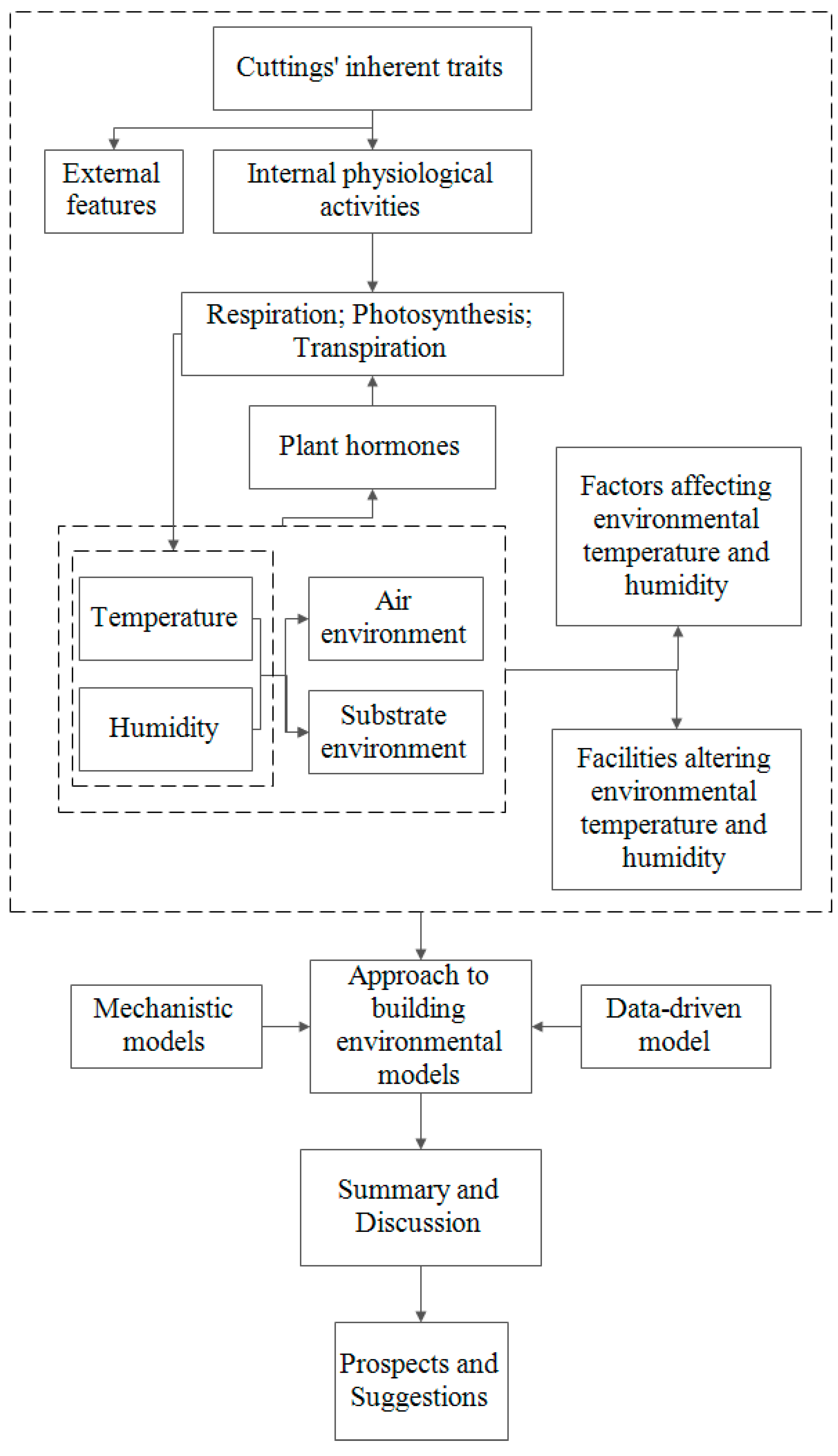

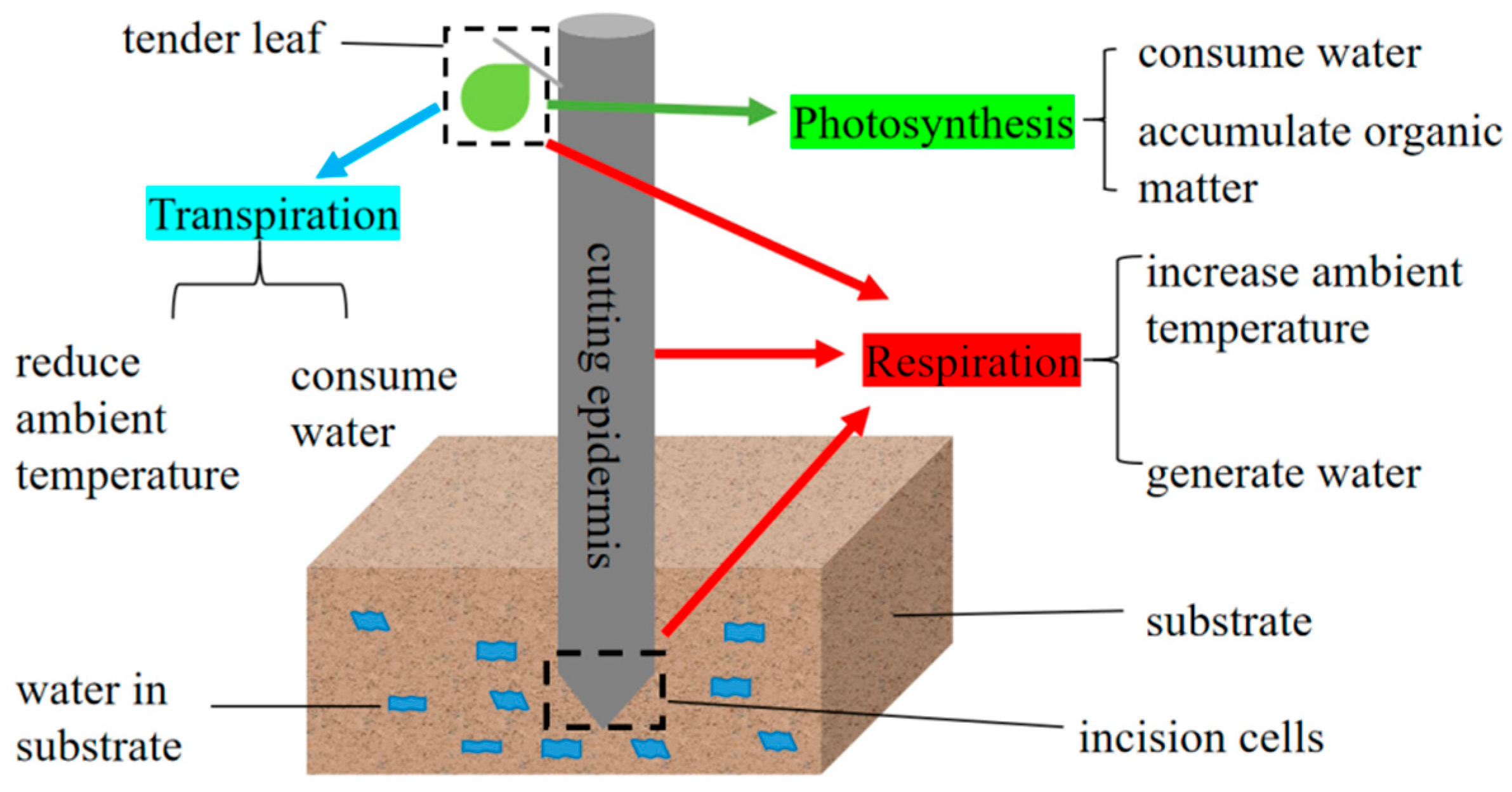
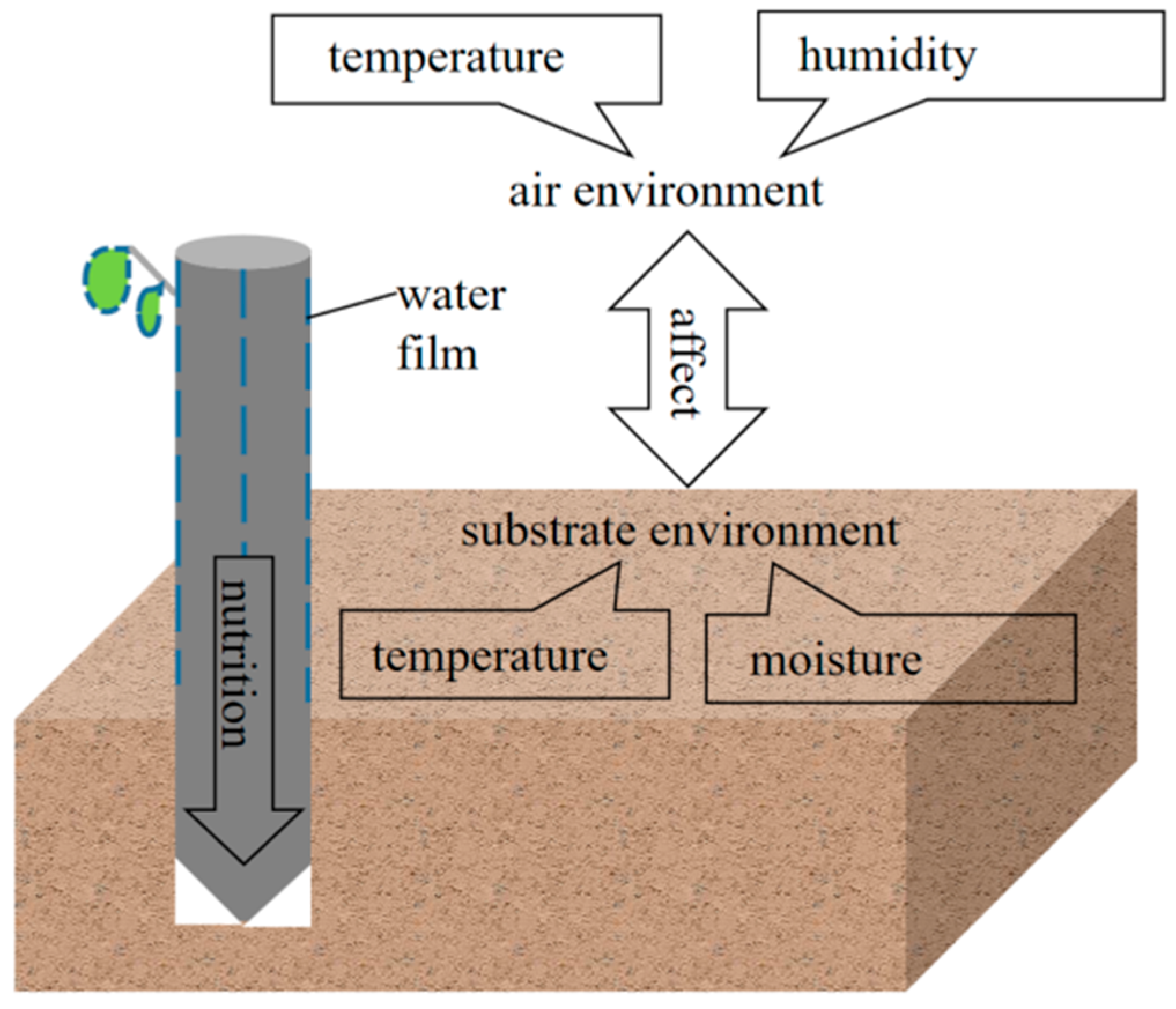
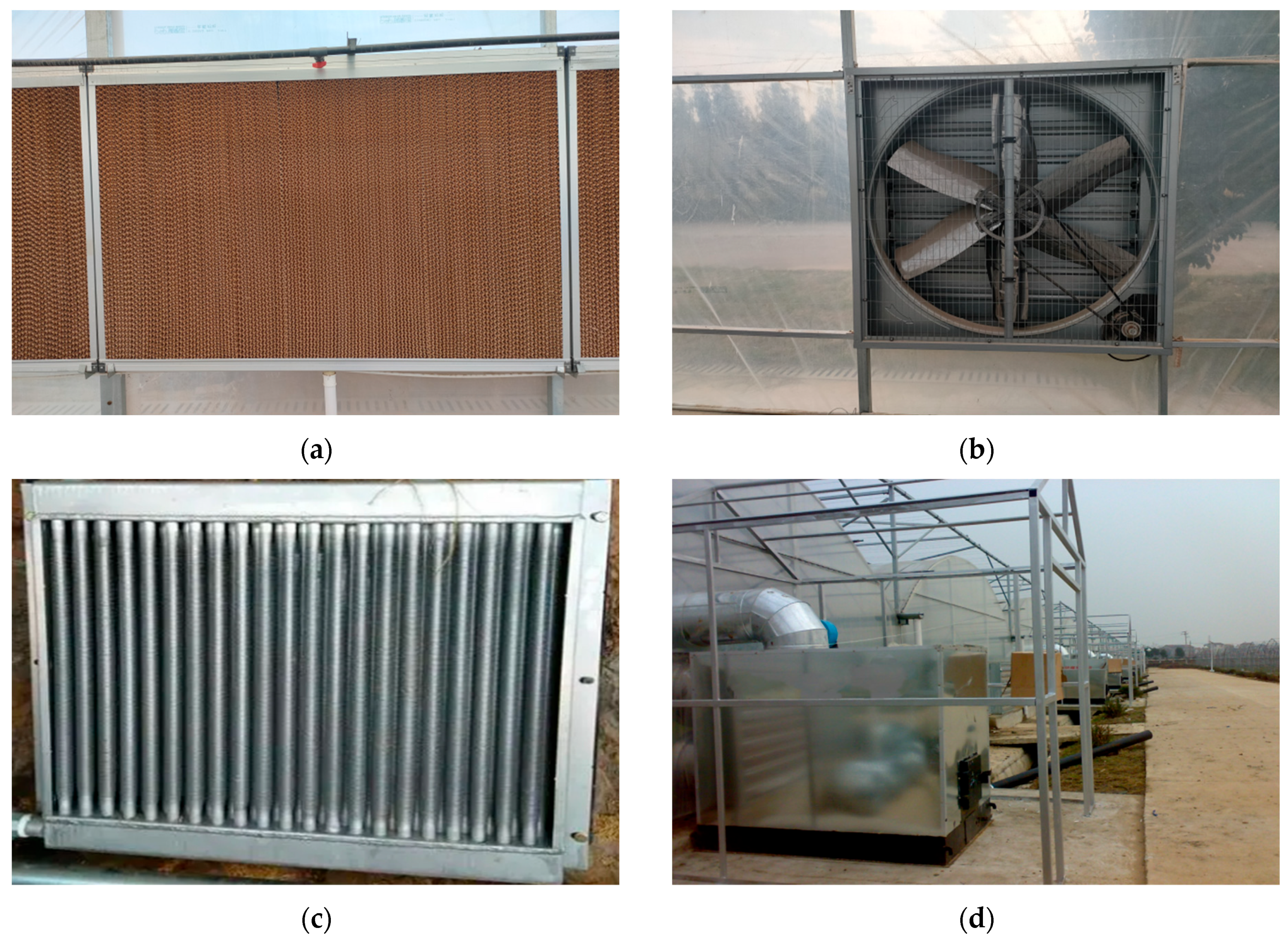
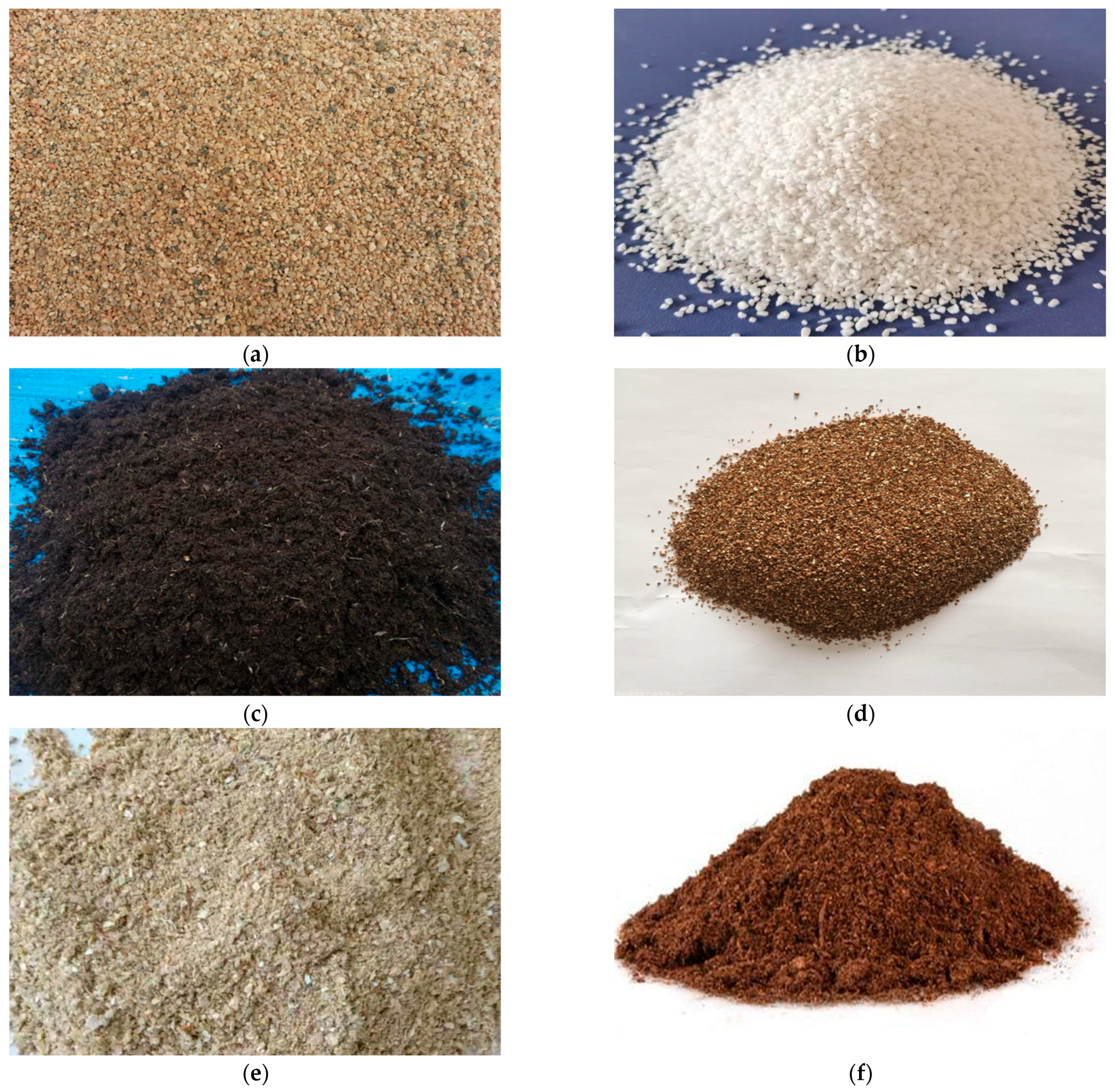
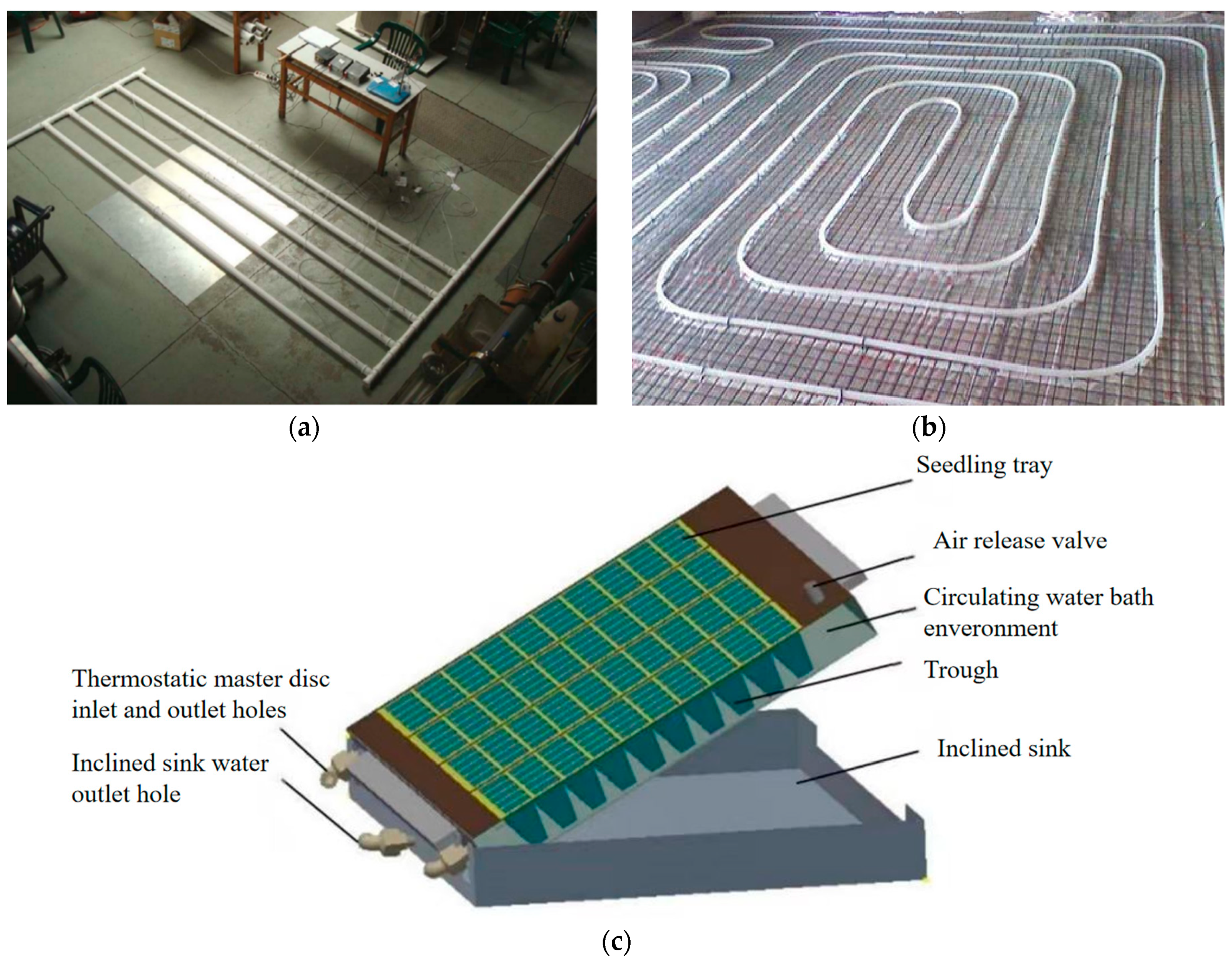
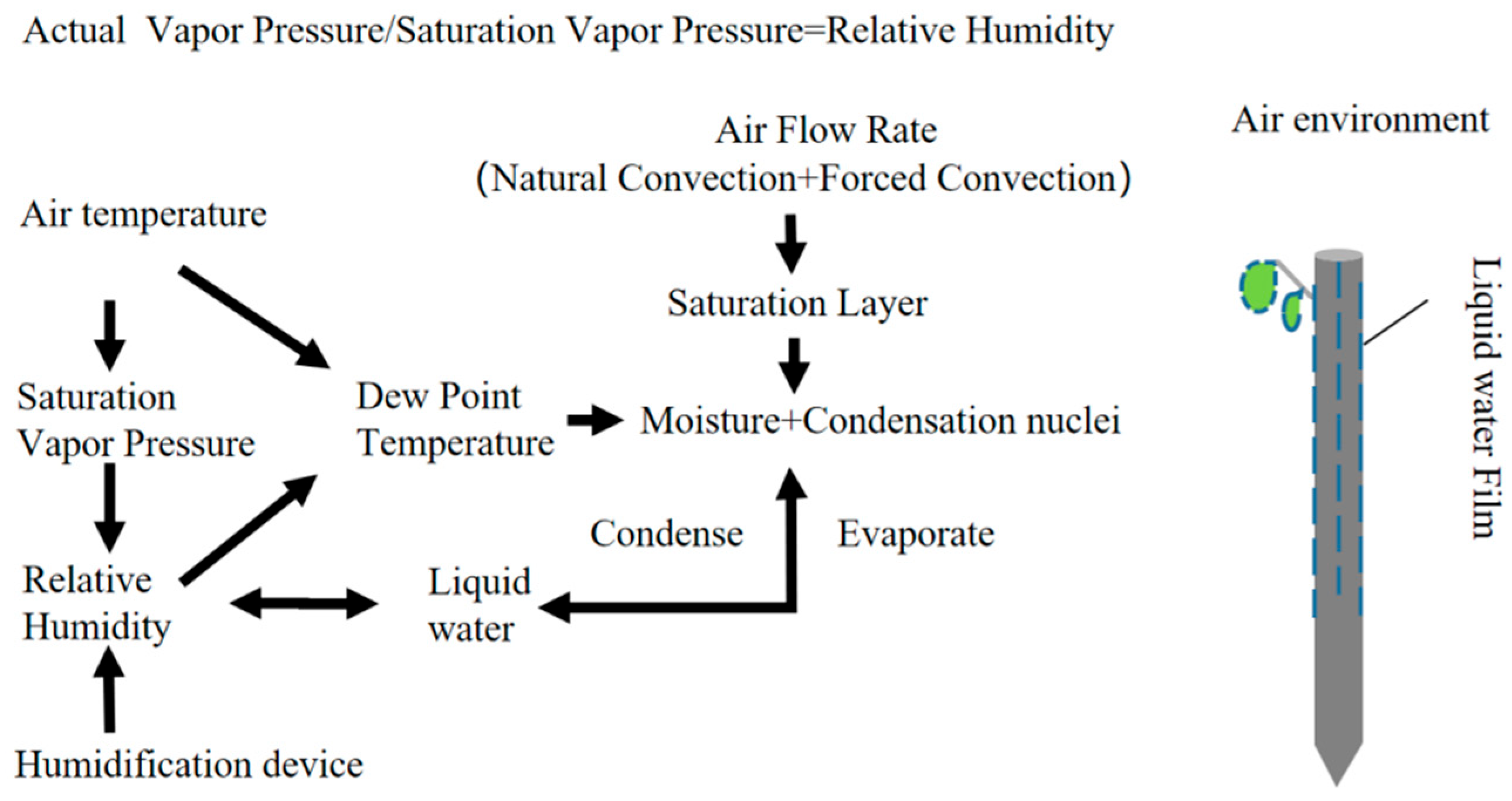

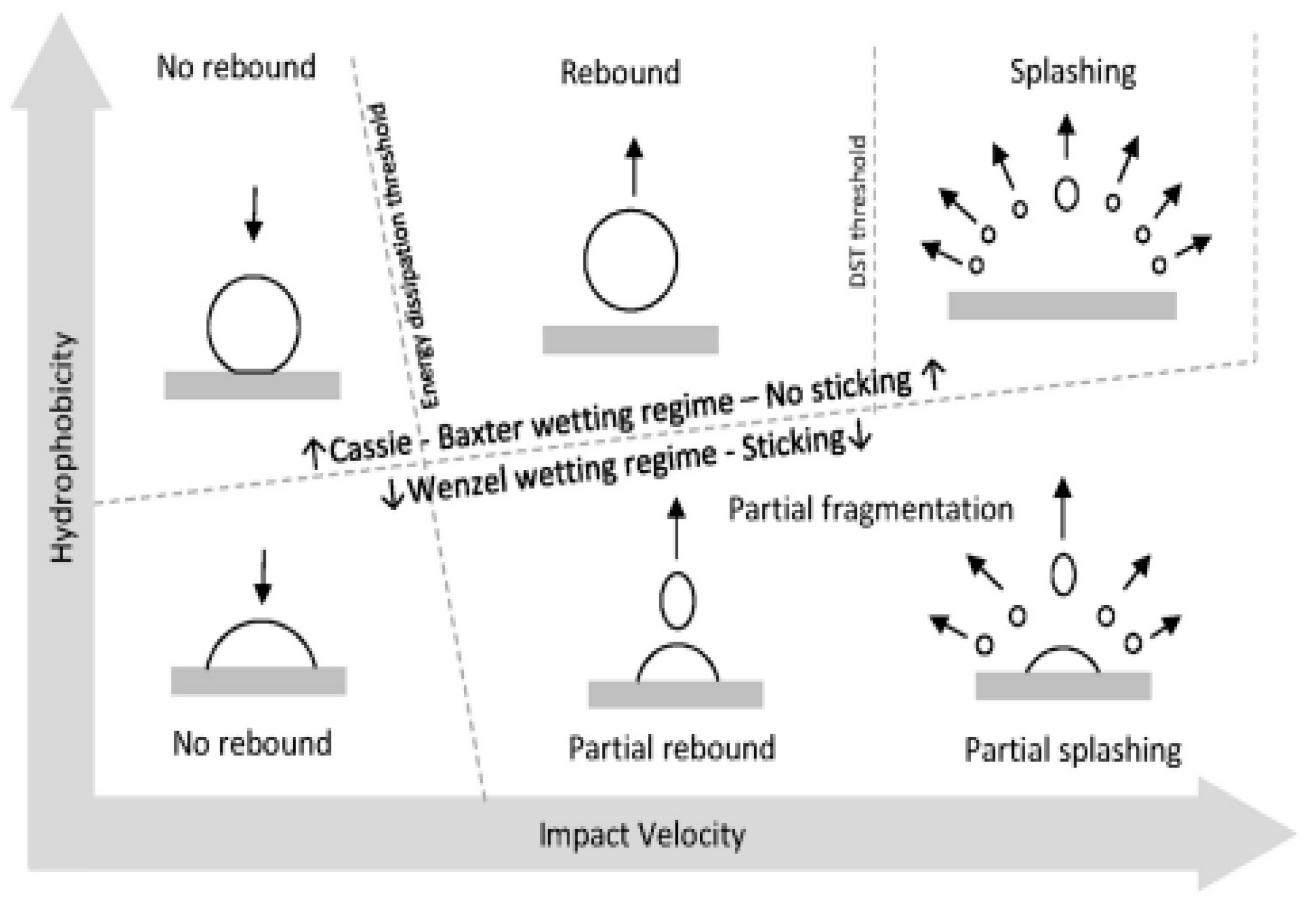

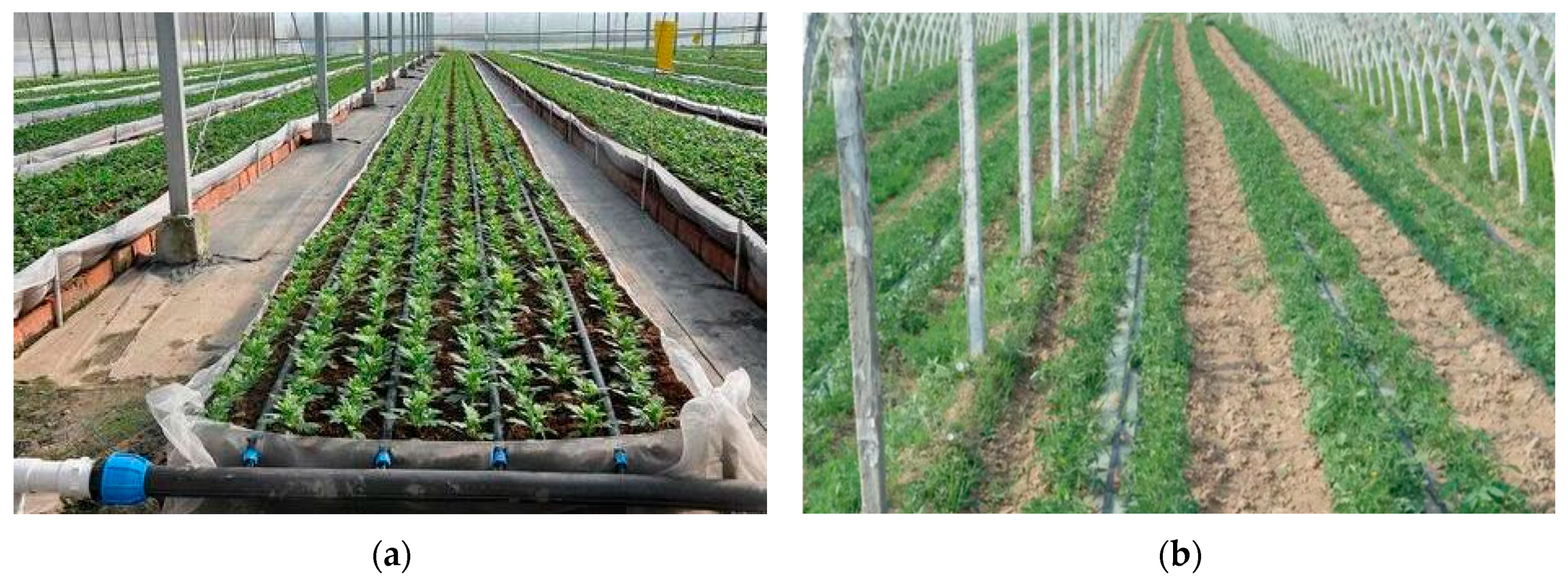
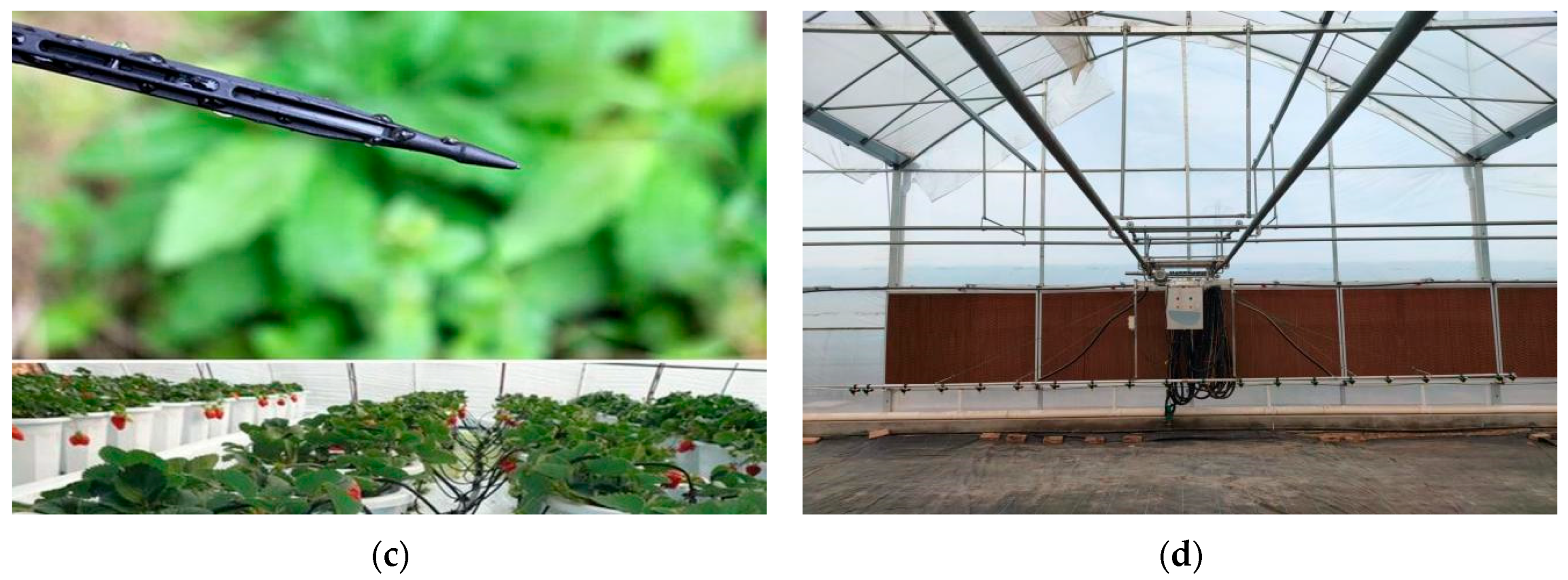

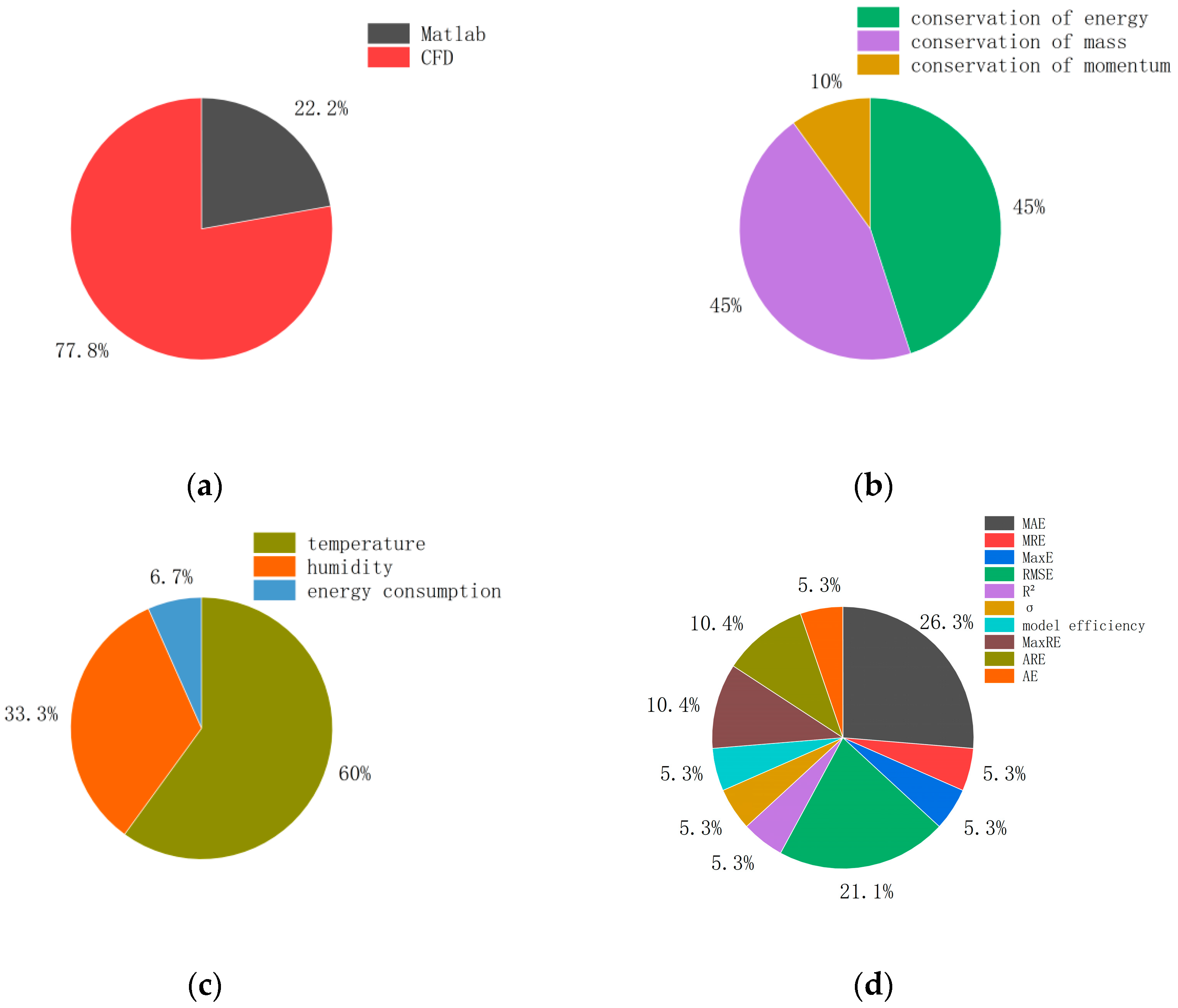
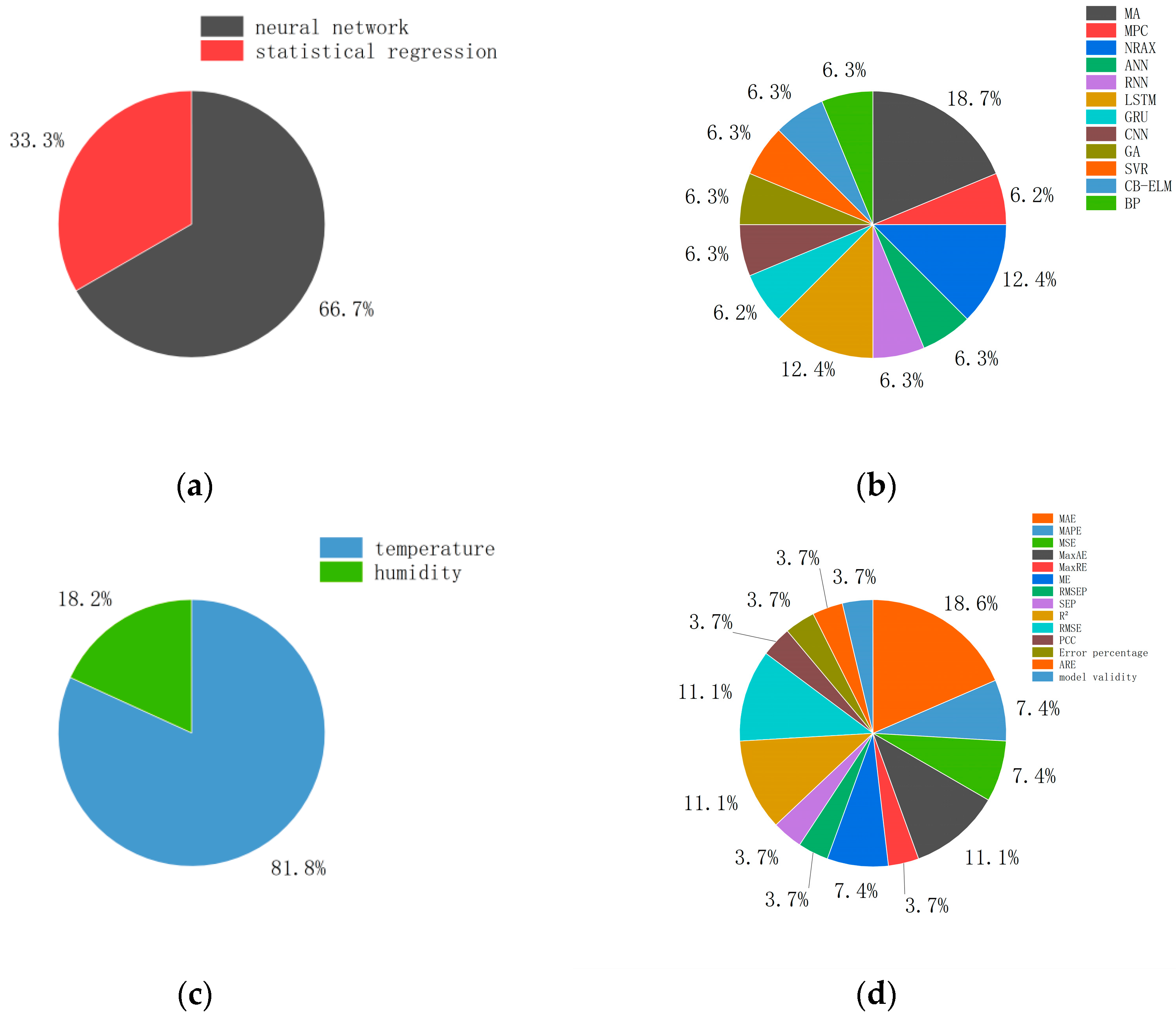
| Growth Stage | Cuttage 0–12 Days | Cuttage 13–16 Days | Cuttage 17–30 Days | |||||||||
|---|---|---|---|---|---|---|---|---|---|---|---|---|
| Time | 5:00–19:00 | 19:00–5:00 | 5:00–19:00 | 19:00–5:00 | 5:00–19:00 | 19:00–5:00 | ||||||
| Environment | Air | Substrate | Air | Substrate | Air | Substrate | Air | Substrate | Air | Substrate | Air | Substrate |
| Temperature (°C) | 22 | 24 | 18 | 20 | 24 | 26 | 16 | 18 | 24 | 26 | 16 | 18 |
| Substrate Material | Heat Conductivity (W/(m·K)) | Density (g/cm3) | Calorific Capacity (J/(g·K)) | Thermal Diffusivity (mm²/s) |
|---|---|---|---|---|
| River Sand | 0.2–1.5 | 1.4–2.7 | 0.8–1.2 | 0.1–1.0 |
| Perlite | 0.06–0.2 | 0.8–2.9 | 0.8–1.2 | 0.1–1.0 |
| Turfy Soil | 0.03–0.4 | 0.1–0.3 | 1.0–1.5 | 0.1–1.0 |
| Vermiculite | 0.04–0.07 | 2.2–2.8 | 0.8–1.2 | 0.1–1.0 |
| Rice Hull | 0.03–0.1 | 0.1–0.2 | 1.4–1.8 | 0.1–1.0 |
| Redheart Soil | 0.2–1.5 | 1.2–1.8 | 0.8–1.5 | 0.1–1.0 |
| Coconut Bran | 0.03–0.1 | 0.1–0.2 | 1.5–2.5 | 0.1–1.0 |
| Spray Form | Droplet Size (μm) | Suspension Time |
|---|---|---|
| Aerosol Spray | 1–10 | Long |
| Mist Spray | 10–100 | Comparatively Long |
| Spray Drift | 100–1000 | Comparatively Short |
| Drift Spray | 1000–100,000 | Short |
| Substrate Material | Size | Particle Size (mm) | Water-Holding Capacity | Water Discharge Capacity | Reference |
|---|---|---|---|---|---|
| River Sand | Gravel | >2 mm | Relatively Weak | Relatively Strong | [174,175,176,177] |
| Coarse Sand | 0.25–2 | ||||
| Medium Sand | 0.12–0.25 | ||||
| Fine Sand | 0.06–0.125 | ||||
| Very Sine Sand | 0.03–0.06 | ||||
| Perlite | Coarse Particle | 2.12–5.38 | Relatively Good | Relatively Weak | [178,179] |
| Medium Particle | 0.51–2.01 | ||||
| Fine Particle | 0.13–0.52 | ||||
| Peat | Coarse Particle | 2.21–5.32 | Good | Weak | [180,181] |
| Medium Particle | 0.53–2.23 | ||||
| Fine Particle | 0.14–0.48 | ||||
| Vermiculite | Coarse Particle | 2.09–5.22 | Relatively Good | Relatively Weak | [182,183,184] |
| Medium Particle | 0.52–2.01 | ||||
| Fine Particle | 0.13–0.53 | ||||
| Peanut Shell | Coarse Particle | 2.17–5.32 | Good | Weak | [185,186] |
| Medium Particle | 0.48–2.01 | ||||
| Fine Particle | 0.11–0.51 | ||||
| Coconut Chaff | Coarse Particle | 2.24–5.13 | Good | Weak | [187,188] |
| Medium Particle | 0.53–2.02 | ||||
| Fine Particle | 0.12–0.52 |
| Model | Construction Principle | Instrument | Study Subjects | Key Influence Factor | Model Type | Evaluation Index | References |
|---|---|---|---|---|---|---|---|
| Air Exchange Rate Model | Conservation of Energy, Conservation of Mass | Matlab | Temperature, Humidity | Ventilation Flow Rate, Evaporation Rate, Atomized Water Volume, Air Heat Capacity | Nonlinearity | Average Error (MAE) | Pasgianos [196] |
| Plastic Tunnel Greenhouse Climate and Crop Heat Exchange | Conservation of Energy, Conservation of Mass | CFD | Temperature, Humidity | Solar Radiation Intensity, Transpiration, Ventilation Speed | Nonlinearity | Average Error (MAE) | Boulard [197] |
| Climate Distribution Model in Greenhouse | Conservation of Energy, Conservation of Mass | CFD | Temperature | Ventilation Flow, Intake Temperature, Intake Speed | Nonlinearity | Average Error (MAE) | Liu [198] |
| Summer Greenhouse Cooling Simulation Model | Conservation of Energy, Conservation of Momentum, Conservation of Mass | CFD | Temperature | Solar Radiation Intensity, Crop Physiological Activity, Wind Speed, Wet Curtain Area, Greenhouse Length | Nonlinearity | Average Error (MAE), Relative error (MRE), Maximum Absolute Error (MaxE) | Xu [199] |
| Microclimate Model of Gable Greenhouse | Conservation of Energy, Conservation of Mass | CFD | Temperature, Humidity | Solar Radiation Intensity, Ventilation Wind Speed, Ventilation Direction | Nonlinearity | Root-Mean-Square Error (RMSE) | Saberian [200] |
| Greenhouse Temperature Prediction Model Under Natural Ventilation | Conservation of Energy, Conservation of Momentum, Conservation of Mass | Matlab | Temperature | Crop Leaf Surface Temperature, Indoor Air Temperature, Soil Temperature | Nonlinearity | Determination Coefficient (R2), Standard Deviation () Root-Mean-Square Error (RMSE) Model Efficiency () | Singh [201] |
| Spatial and Temporal Variation Characteristic Factor Optimization Model of Greenhouse Environment | Conservation of Energy, Conservation of Mass | CFD | Temperature, Humidity, Energy Consumption | Soil Temperature, Soil Density, Air Density, Indoor Air Temperature, Greenhouse Roof Temperature, Wind Speed | Nonlinearity | Maximum Relative Error (MaxRE), Average Relative Error (ARE), Root-Mean-Square Error (RMSE) | Li [202] |
| Temperature and Water Vapor Distribution Model in Glass Greenhouse | Conservation of Energy, Conservation of Mass | CFD | Temperature, Humidity | Crop Leaf Area, Solar Radiation Intensity, Plant Cover Temperature, Photosynthesis, Respiration, Transpiration Heat, Water Vapor Volume | Nonlinearity | Root-Mean-Square Error (RMSE) | Boulard [203] |
| Greenhouse Thermal Storage Rear Wall Model | Conservation of Energy, Conservation of Mass | CFD | Temperature | Wall Temperature, Hot Air Duct Temperature, Length of Hot Air Duct | Nonlinearity | Absolute Error(AE), Average Error (MAE), Average Relative Error (ARE), Maximum Relative Error (MaxRE) | Zhang [204] |
| Model | Type | Instrument | Study Subjects | Key Influence Factor | Model Type | Evaluation Index | References |
|---|---|---|---|---|---|---|---|
| Temperature Prediction Model | Statistical Regression Method | Matlab, Least Squares Support Vector Machine (LSSVM), Intelligent Particle Swarm Optimization (IPSO) | Temperature | Air Temperature, Air humidity, Soil Temperature, Soil moisture, Solar Radiation Intensity, Outdoor Temperature | Nonlinearity | Mean Absolute Error (MAE), Mean Percentage Error (MAPE), Mean Square Error (MSE) | Yu [207] |
| Temperature Prediction System | Neural Network | Time Sequence Forecast Model (ARMA) | Temperature | Air Temperature, Air humidity, Light Intensity | Nonlinearity | Maximum Absolute Error (MaxAE), Maximum Relative Error (MaxRE), Mean Relative Error (MRE) | Ren [208] |
| Solar Greenhouse Temperature Prediction Model | Neural Network | Model Predictive Control (MPC), Nonlinear Autoregressive Exogenous Model (NRAX) | Temperature | Wind Speed of Fan, Wet Curtain State, Solar Radiation Intensity, Air Humidity | Nonlinearity | Mean error (ME) | Du [209] |
| Velon Greenhouse Climate Prediction Model | Neural Network | Artificial Neural Network (ANN), Nonlinear Autoregressive Exogenous Model (NRAX), Recurrent Neural Network (RNN), Long Short-Term Memory Network (LSTM) | Temperature, Humidity | Air humidity, air Temperature, CO2 Concentration | Nonlinearity | Mean error (ME), Root-Mean-Square Error Prediction (RMSEP), Standard Error Prediction (SEP), Determination Coefficient (R2) | Jung [210] |
| Agricultural Low Temperature Prediction Model | Neural Network | Long short-term memory network (LSTM) | Temperature | Air Temperature, Air humidity, Wind Speed | Nonlinearity | Root-Mean-Square Error (RMSE), Determination Coefficient (R2), Mean Absolute Error (MAE), Pearson’s Correlation Coefficient (PCC), Error Percentage | Guillén-Navarro M Á [211] |
| Solar Greenhouse Temperature Prediction Model | Neural Network | One-Dimensional Neural Network, Gated Cycle Unit (GRU), Convolutional Neural Network (CNN) | Temperature | Light Intensity, Indoor Soil Temperature, Outdoor Soil Temperature, Outdoor Air Temperature, Outdoor soil Moisture Content, Outdoor CO2 Concentration | Nonlinearity | Determination Coefficient (R2), Root-Mean-Square Error (RMSE), Mean Absolute Error (MAE), Maximum Absolute Error (MaxAE), Average Relative Error (ARE) | Hu [212] |
| Prediction of Greenhouse Temperature of Edible Fungi | Statistical Regression Method | Moving Average (MA), Autoregressive Integrated Moving Average Model (ARIMA), Genetic Algorithm (GA), Support Vector Regression (SVR) | Temperature | Moving Average Window Length, Indoor Temperature at 3 o’ clock | Nonlinearity | Mean Relative Error (MAE), Mean Square Error (MSE), Mean Absolute Percentage Error (MAPE) | Tian [215] |
| Solar Greenhouse Temperature and Humidity Prediction Model | Statistical Regression Method | Convex Bidirectional Extremum Learning Machine (CB-ELM) | Temperature, Humidity | Solar Radiation Intensity, Wind speed, Outdoor Temperature, Outdoor Humidity | Nonlinearity | Root-Mean-Square Error (RMSE), Model Validity | Zou [216] |
| Solar Greenhouse Temperature Prediction Model | Neural Network | Backpropagation Neural Network (BP) | Temperature | Indoor Temperature, Indoor Humidity, Indoor Light Intensity | Nonlinearity | Mean Absolute Error (MAE), Mean Relative Error (MRE), Maximum Absolute Error (MaxAE) | Zhao [217] |
| Model | Mechanism Model | Data-Driven Model |
|---|---|---|
| Common point | The main research objects are ambient temperature and humidity, among which temperature accounts for more. All models are nonlinear models. They are predictive. | |
| Advantages | A process-oriented visual description of the space–time change of matter | Fast induction of input/output relationships for high dimensional data |
| Disadvantages | The boundary conditions need to be tested in practice | The quality of training data is high and the amount of feature data is large |
| Individualized improvement plan | The boundary conditions that are difficult to measure are derived by using deep learning methods | The mechanism model is used to screen the influential factors and reduce the dimension of the input data |
| Common improvement plan | The content and distribution of plant hormones were used as important parameters to analyze the intensity of plant physiological activities. They should be important parameters for constructing environmental models. | |
Disclaimer/Publisher’s Note: The statements, opinions and data contained in all publications are solely those of the individual author(s) and contributor(s) and not of MDPI and/or the editor(s). MDPI and/or the editor(s) disclaim responsibility for any injury to people or property resulting from any ideas, methods, instructions or products referred to in the content. |
© 2023 by the authors. Licensee MDPI, Basel, Switzerland. This article is an open access article distributed under the terms and conditions of the Creative Commons Attribution (CC BY) license (https://creativecommons.org/licenses/by/4.0/).
Share and Cite
Wang, X.; Liu, L.; Xie, J.; Wang, X.; Gu, H.; Li, J.; Liu, H.; Wang, P.; Yang, X. Research Status and Prospects on the Construction Methods of Temperature and Humidity Environmental Models in Arbor Tree Cuttage. Agronomy 2024, 14, 58. https://doi.org/10.3390/agronomy14010058
Wang X, Liu L, Xie J, Wang X, Gu H, Li J, Liu H, Wang P, Yang X. Research Status and Prospects on the Construction Methods of Temperature and Humidity Environmental Models in Arbor Tree Cuttage. Agronomy. 2024; 14(1):58. https://doi.org/10.3390/agronomy14010058
Chicago/Turabian StyleWang, Xu, Lixing Liu, Jinyan Xie, Xiaosa Wang, Haoyuan Gu, Jianping Li, Hongjie Liu, Pengfei Wang, and Xin Yang. 2024. "Research Status and Prospects on the Construction Methods of Temperature and Humidity Environmental Models in Arbor Tree Cuttage" Agronomy 14, no. 1: 58. https://doi.org/10.3390/agronomy14010058
APA StyleWang, X., Liu, L., Xie, J., Wang, X., Gu, H., Li, J., Liu, H., Wang, P., & Yang, X. (2024). Research Status and Prospects on the Construction Methods of Temperature and Humidity Environmental Models in Arbor Tree Cuttage. Agronomy, 14(1), 58. https://doi.org/10.3390/agronomy14010058






